For quite some time, people have said that America is the next Roman Empire and that, like all empires, it too will fall.
Historically speaking, that assumption would be correct. Empires have risen and crumbled throughout history. But what were the largest and most powerful empires throughout history?
Let's take a look at the world's biggest empires. We ranked them by the landmass they controlled at their height. The biggest empire in the world controlled a quarter of the world's land. Can you guess what it is?
35. Dzungar Khanate
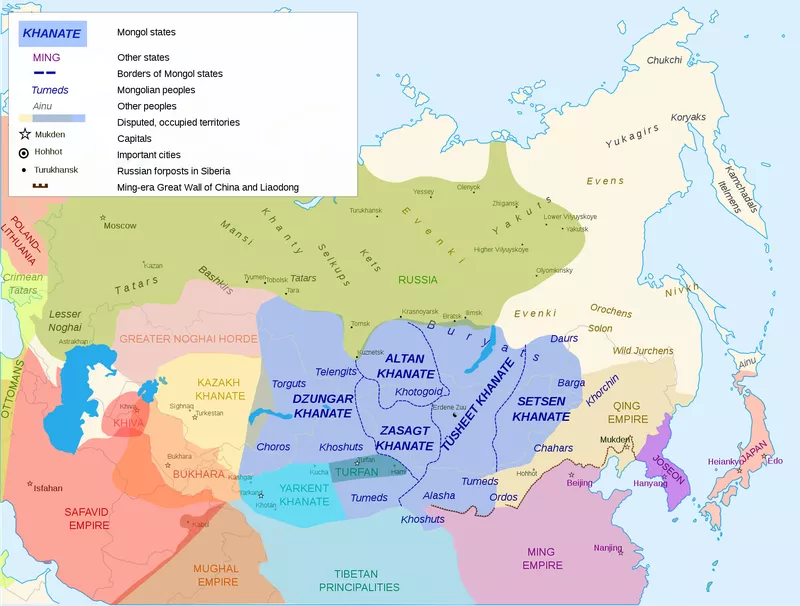
Elvonudinium / Wikimedia Commons
Years: 1634–1755
Maximum land area year: 1650
Millions of square miles occupied: 1.39
Percentage of the world: 2.67
The Genocide of a Tribal Collective
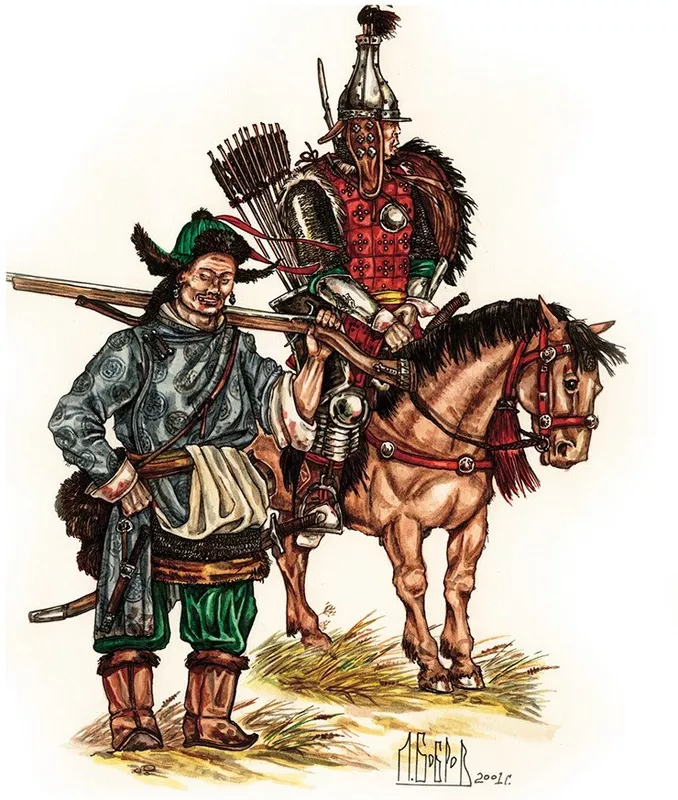
naukatehnika.com / Wikimedia Commons
The Dzungar Khanate was a collective of Oirat tribes that lived between the Great Wall of China and Kazakhstan in Central Asia. After the Dzungars unified, the khanate was established in 1634. Its leader, Galdan, campaigned for an Oirat state in Mongolia and Xinjiang.
Galdan was defeated at the Battle of Jao Modo in 1696 by the Qing Dynasty. In 1717, they conquered Tibet, but that was also short-lived. They were only there for a year before being driven out by the Qing.
The Qing then took advantage of a civil war between the Dzungar and conquered them. Scholars believe about 80 percent of of the Dzungars were wiped out due to war and disease by 1757.
How well do you know powerful influencers? Test your knowledge with this famous people in history quiz from Huge Quiz.
34. Ilkhanat
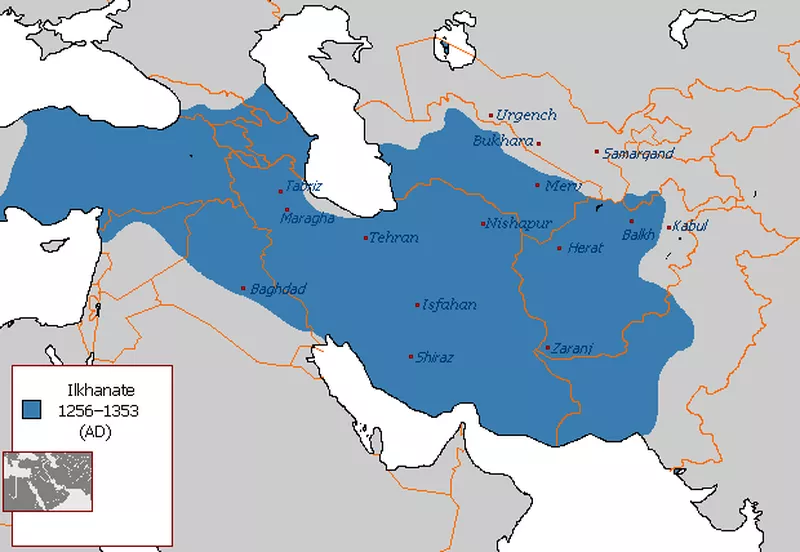
Arab League / Wikipedia
Years: 1256-1335
Maximum land area year: 1310
Millions of square miles occupied: 1.45
Percentage of the world: 2.78
The Ilkhanat Is Wiped Out by the Black Death
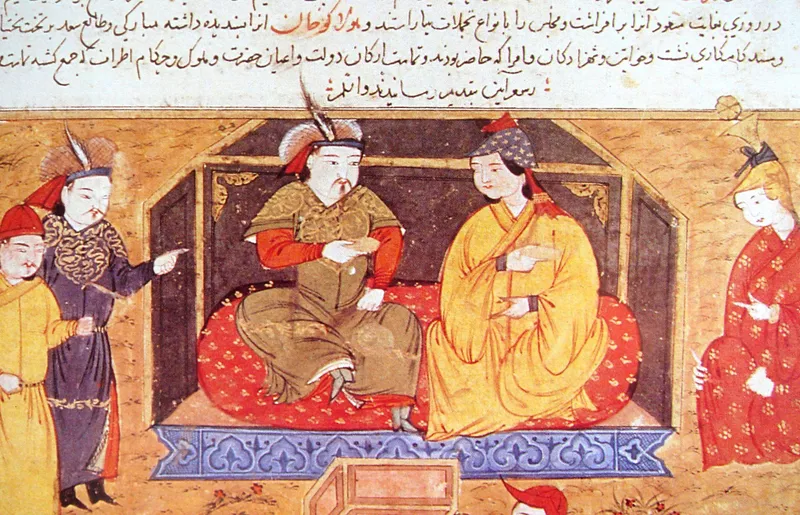
Rachid Ad-Din / Wikipedia
The Ilkhanat Empire covered parts of modern-day Afghanistan, Armenia, Iraq, Pakistan, Turkey and Turkmenistan. It was one of four khanates that were formed in 1256 by Hulegu, a Mongol general.
During this time, the Mongol Empire had eased trade and commerce across Asia, which the Ilkhanate and China's Yuan Dynasty encouraged.
After Hulegu died, his son Abaqa Khan became the Ilkhanat's leader, and its rulers started converting to Islam toward the end of the 13th century. After its last ruler, Abu Sa’id Bahadur Khan, died in 1335 with no heir, the Ilkhanat began to disintegrate. The Black Death also aided in their demise.
RELATED: What Life in Ancient Rome Was Really Like
33. Italian Empire
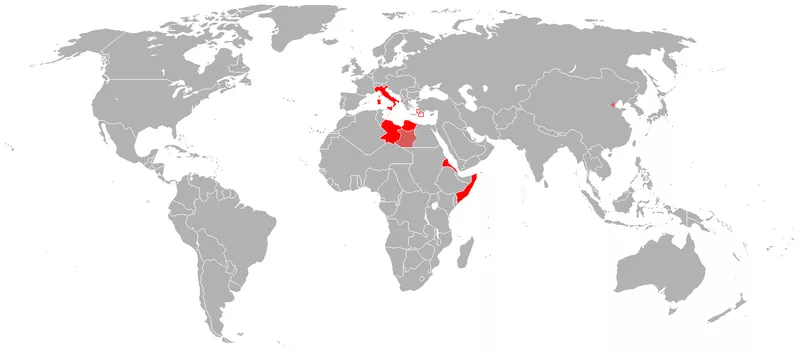
R-41 / Wikpedia
Years: 1882-1947
Maximum land area year: 1941
Millions of square miles occupied: 1.48
Percentage of the world: 2.84
Fascism and Colonization Under the Italian Empire
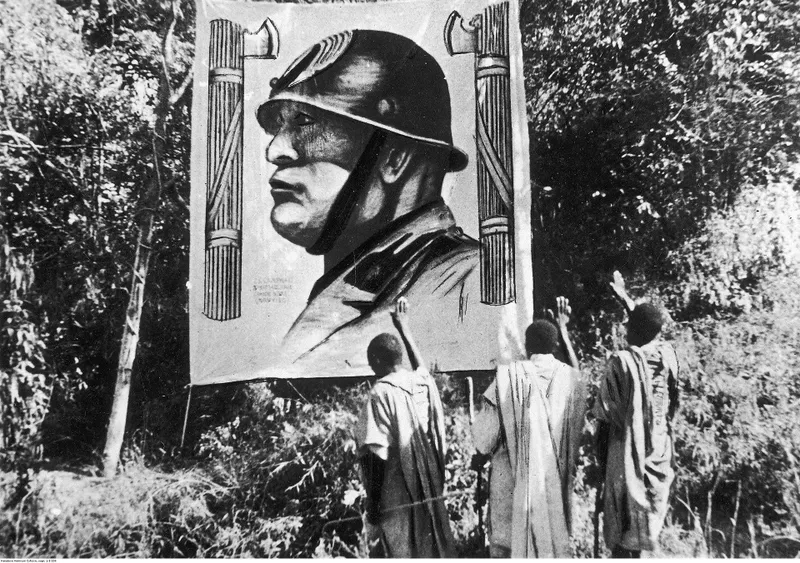
www.audiovis.nac.gov.pl / Wikipedia
The Italian Empire came into being after Italy became a unified nation in 1861. The country believed it deserved an overseas empire and set its sights on Africa, as European nations had done.
In 1882, Italy invaded Eritrea, and seven years later, it conquered Somalia. In 1895, it tried to conquer Ethiopia, but it failed. It didn't stop there and in 1911, Italy took Libya.
Benito Mussolini vowed to expand the empire even further to avenge the country's Ethiopian defeat. Under Mussolini, the Italians took Albania using chemical weapons in 1939.
In April 1941, he started to plan dominance of the coastlines around the Mediterranean Sea. However, with the arrival of Allied forces, its empire had ceased to exist by 1943.
RELATED: Top 15 Most Famous Men in History
32. Seleucid Empire
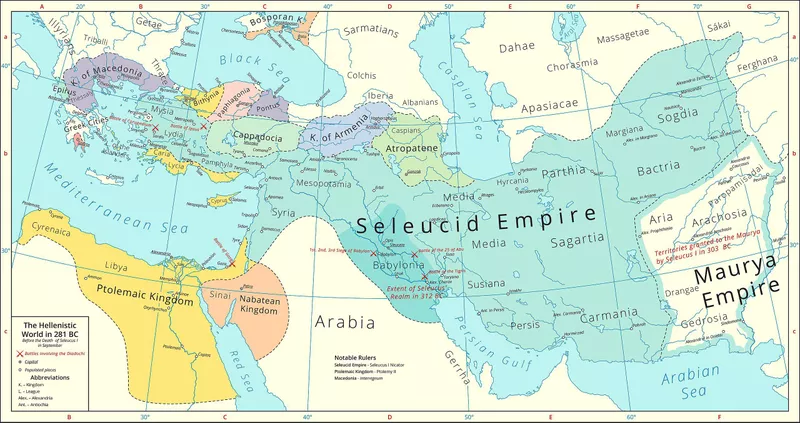
Cattette / Wikipedia
Years: 312 B.C.-63 B.C.
Maximum land area year: 301 B.C.
Millions of square miles occupied: 1.51
Percentage of the world: 2.89
The Seleucid Empire Created a Harmonious State
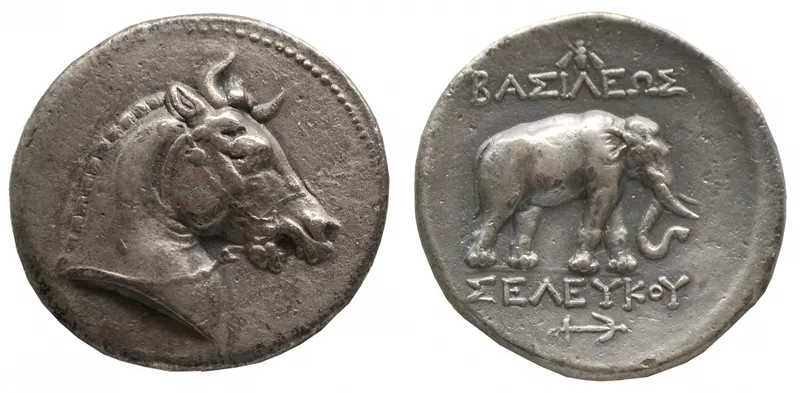
Hartmann Linge / Wikipedia
The Seleucid Empire was established by Seleucus I Nicator, a general of Alexander the Great, who came to power after Alexander's death in 323 B.C.
Alexander left no heirs and stated that the kingdom should go to the "the strongest," which led to rivalry between his top generals and split his territory between all of them.
Seleucus was successful in building a harmonious multinational empire merging Eastern and Western cultures.
It stretched from the Mediterranean Sea to South Asia, but ultimately, it became too great to control. Seleucus' successors did not hold fast to his vision, and at the same time, Rome was quickly becoming a Mediterranean superpower and was the empire to topple it.
31. Great Seljuq Empire
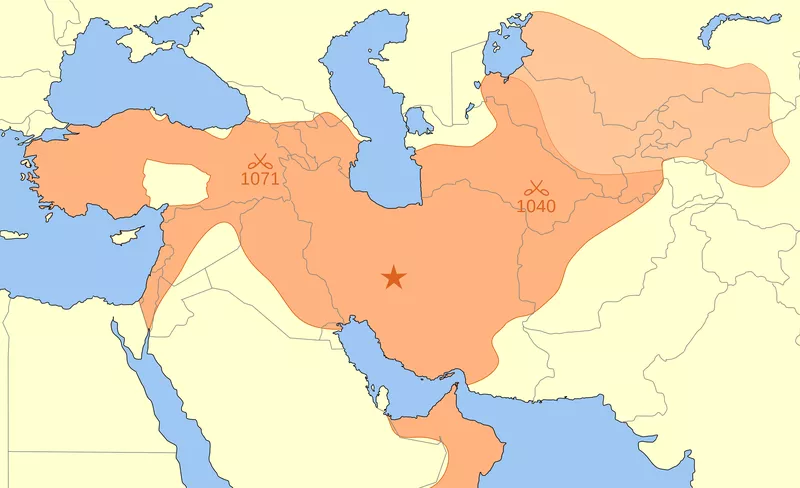
MapMaster / Wikipedia
Years: 1037-1194
Maximum land area year: 1080
Millions of square miles occupied: 1.51
Percentage of the world: 2.89
The Great Seljuq Empire Was a Persian Powerhouse
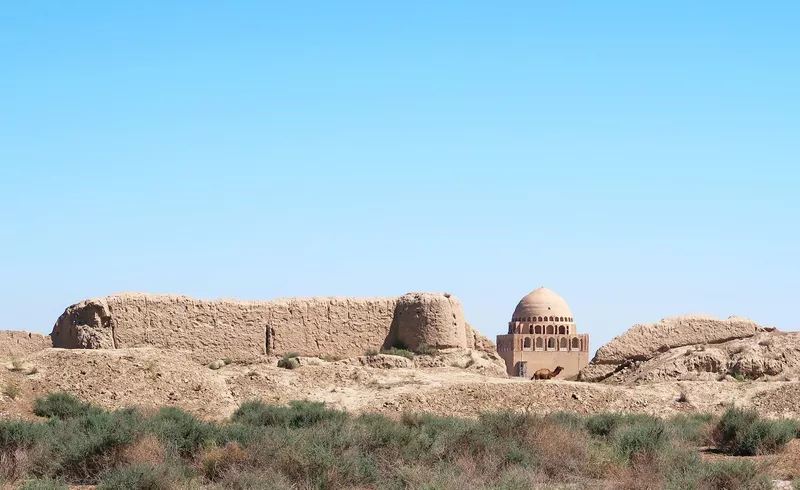
John Pavelka / Wikipedia
This central Asian empire controlled lands from Palestine to Kashgar in western China. It was founded with the arrival of the Seljuks in Nishapur, Iran. Within two years, they seized parts of modern-day Iran, Turkmenistan, and northern Afghanistan.
The Great Seljuk Empire had a wide range of religious, linguistic, and ethnic groups within it. The Seljuks intermarried with Persians and adopted much of Persian culture, including its language. At its peak, the empire controlled all became targets for the Christian invaders.
The Seljuk Empire began to lose its power in the 1140s and was supplanted by the Khwarazmian Empire in 1194.
30. Mughal Empire
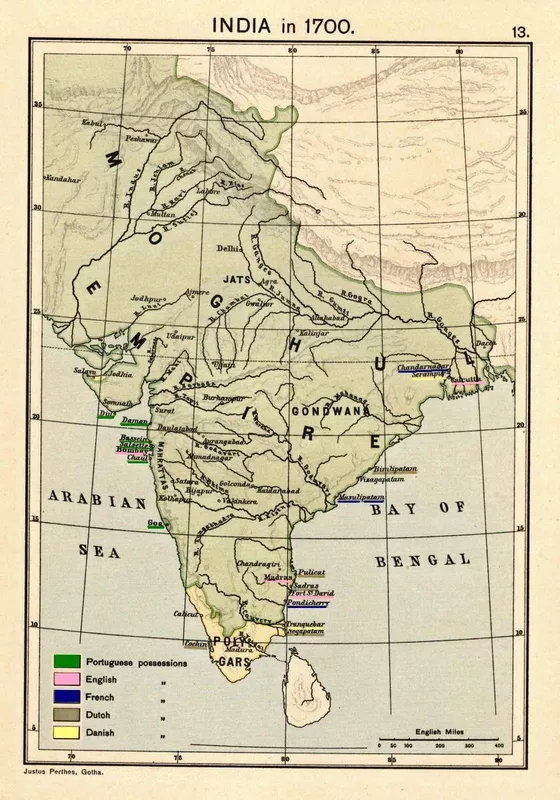
Justus Perthes / Wikipedia
Years: 1526-1857
Maximum land area year: 1690
Millions of square miles occupied: 1.54
Percentage of the world: 2.97
A Unified India Under the Mughal Empire

http://warfare.tk/Moghul/18thC/Shah_Alam_II-18C.htm / Wikipedia
The Mughal Empire stretched across most of India and into Afghanistan. It was founded by a Timurid prince, Babur, who reestablished himself in Kabul and made his way across India.
This empire was critical in bringing the Indian subcontinent under one rule and was notable for its culture influence and achievements in architecture. The famed Taj Mahal was built during this time.
The empire began its swift decline under Muhammad Shah, as its territories fell to the Marathas and eventually the British. India's last Mughal emperor, Bahdur Shah II, was exiled by the British to Rangoon, Burma.
29. Hunnic Empire
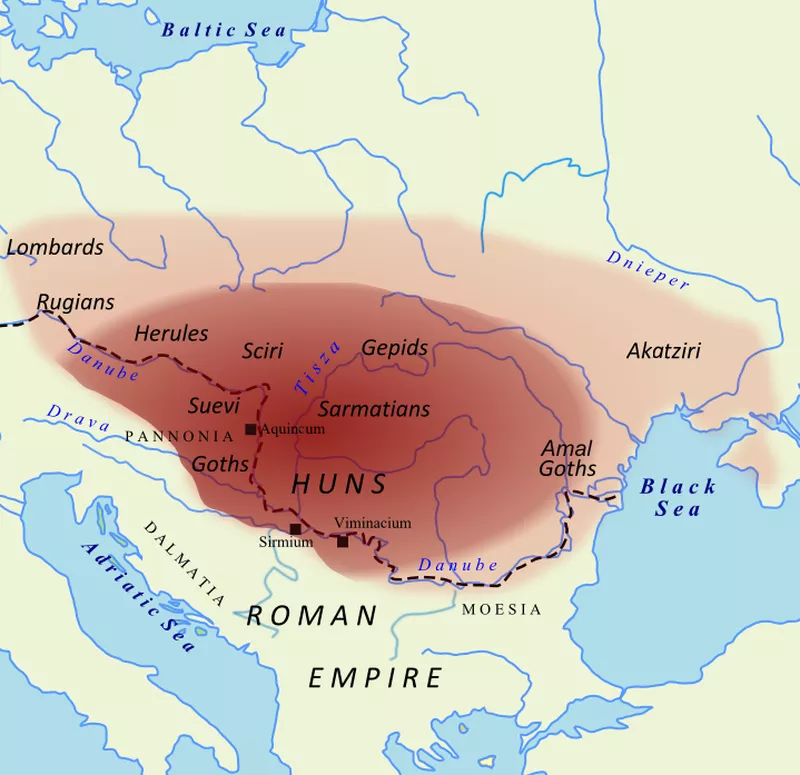
Slovenski Volk / Wikipedia
Years: 370s-469
Maximum land area year: 441
Millions of square miles occupied: 1.54
Percentage of the world: 2.97
The Huns Spared Rome After a Pope's Plea
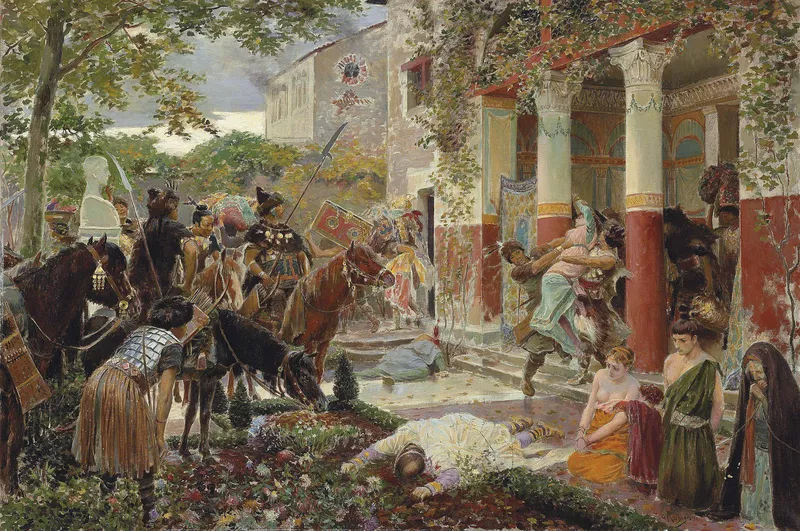
Georges Rochegrosse / Wikipedia
The Hunnic Empire was compromised of Eurasian tribes hailing from the steppes of Central Asia. The Huns were advanced in weaponry, mobility and war tactics and achieved military superiority over their rivals fairly quickly.
The first overran the Alani, who lived between the Volga and the Don rivers in the fourth century and just as quickly, conquered the Ostrogoths between the Don and the Dniester rivers.
Next, they defeated the Visigoths near what is modern-day Romania and challenged the Roman Empire at the Danubian frontier. After making their way into Europe under Attila, they were said to be stopped in Rome by Pope Leo. After a meeting between the two men, The Huns departed, leaving Rome untouched.
Not long after Attila’s death in 469, the empire collapsed.
28. Eastern Turkic Khaganate
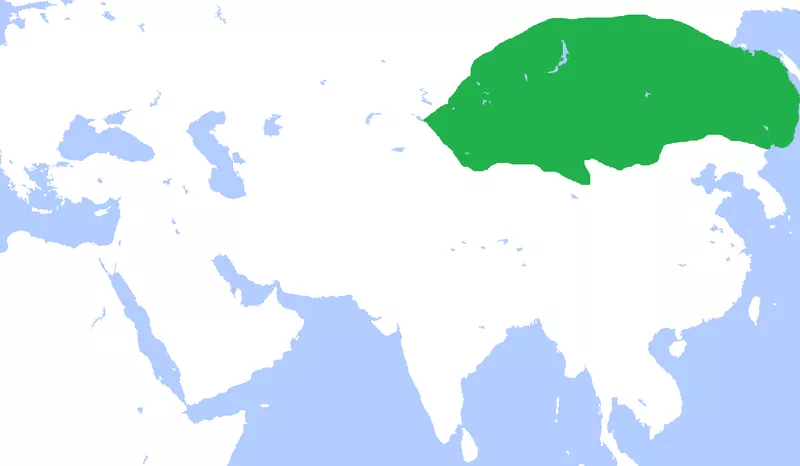
Gabagool / Wikipedia
Years: 581-645
Maximum land area year: 624
Millions of square miles occupied: 1.54
Percentage of the world: 2.97
The Turkic Khaganate Was the First to Use the Turkic Language Officially
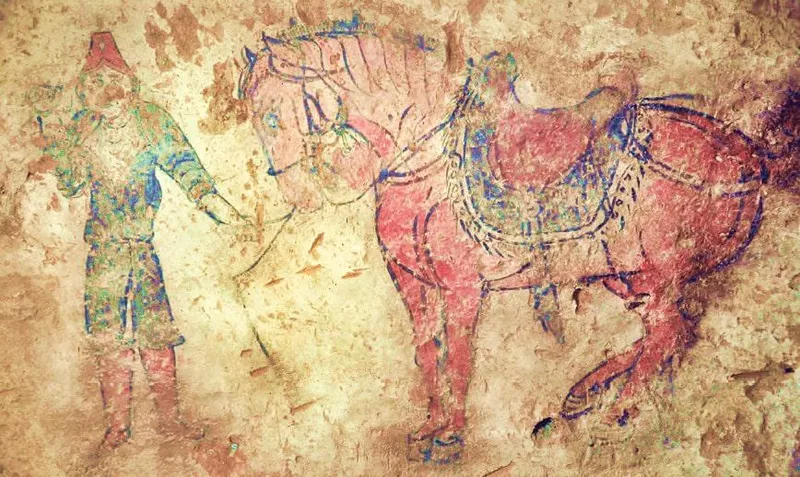
Journal of Social and Humanities Sciences Research / Wikipedia
The Turkic Khaganate was established under leader Bumin Qaghan and his sons, who were members of the Ashina clan of the Göktürks of Inner Asia.
They succeeded the Rouran Khaganate as the dominant power of the Mongolian Plateau expanded in Central Asia fairly quickly. Initially they used the Sogdian language in official functions, but theirs was the first Turkic state to use the Turkic language in written history.
After the Turkic Khaganate collapsed in 581, it was split into eastern and western factions, which were conquered seven years apart by the Tang Empire.
27. Fatimid Caliphate
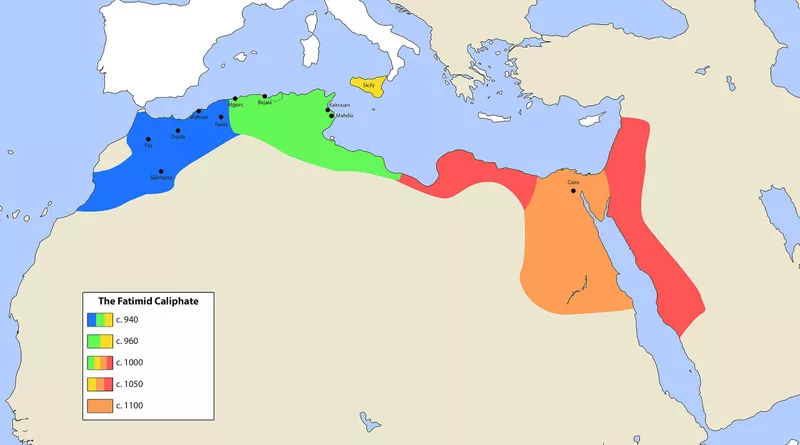
Askelaadden / Wikipedia
Years: 909-1171
Maximum land area year: 969
Millions of square miles occupied: 1.58
Percentage of the world: 3.04
The Advanced Empire of the Fatimid Caliphate

Md iet / Wikipedia
The Fatimid Caliphate was part of the Shia dynasty and ruled the majority of northern Africa.
The Fatimids were extremely advanced — Muslims, Christians and Jews were in its public offices and women's contribution to the culture was highly valued. The Ismaili scholarship sponsored missionaries traveling to India and Central Asia. They developed alternative trade routes to the East, transforming Egypt's economic status, and almost ruled the Muslim world.
But it was not to be. The Zirids of northern Africa declared their independence from the empire. This resulted in invasions from a confederation of Arabian tribes, the Banu Hilal. Turkic invasions followed, then the Crusades and by that time, the Fatimid's empire had shrunk to only Egypt. The country was seized by the Ayyubid dynasty.
26. Timurid Empire
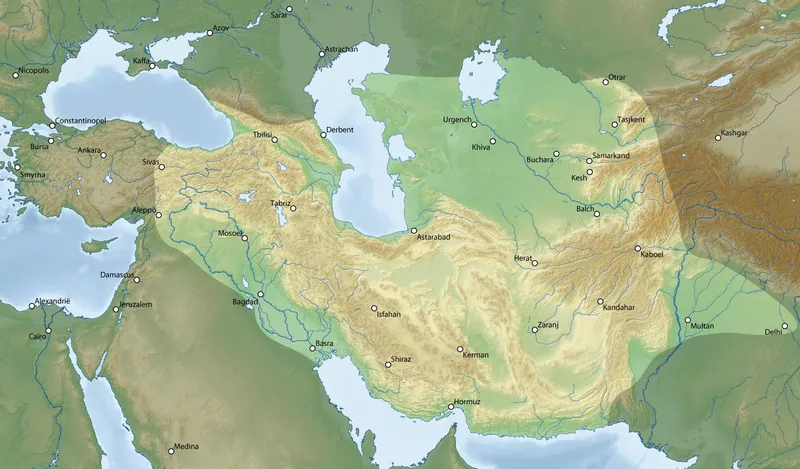
Stuntelaar / Wikipedia
Years: 1370-1405
Maximum land area year: 1405
Millions of square miles occupied: 1.70
Percentage of the world: 3.27
The Timurid Empire Was Established to Restore the Great Mongol Empire
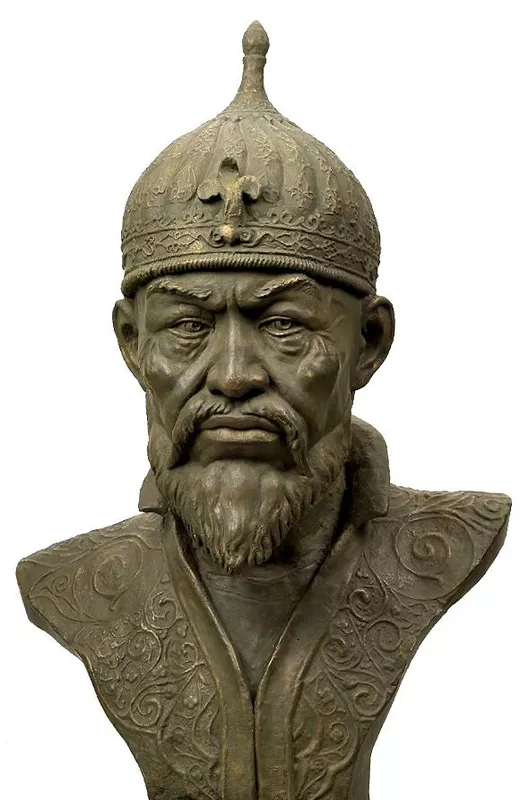
shakko / Wikipedia
The Timurid Empire was formed by the warlord Timur, who was of Turco-Mongol lineage and saw himself as the heir to Genghis Khan's empire. Within 35 years, he conquered all of Central Asia, Iraq, Iran, parts of Russia and India, and Syrian armies to the West.
While preparing to invade China in 1405, he died. His son and successor, Shah Rukh, took his place but did not have the staying power that his father did. Sensing this, other Timurid princes established their own kingdoms, weakening what Timur had begun.
During the empire's remaining years, branches of the Timurid family ruled separate areas until the Timurid Empire was disestablished with the founding of the Mughal Empire.
25. First Mexican Empire
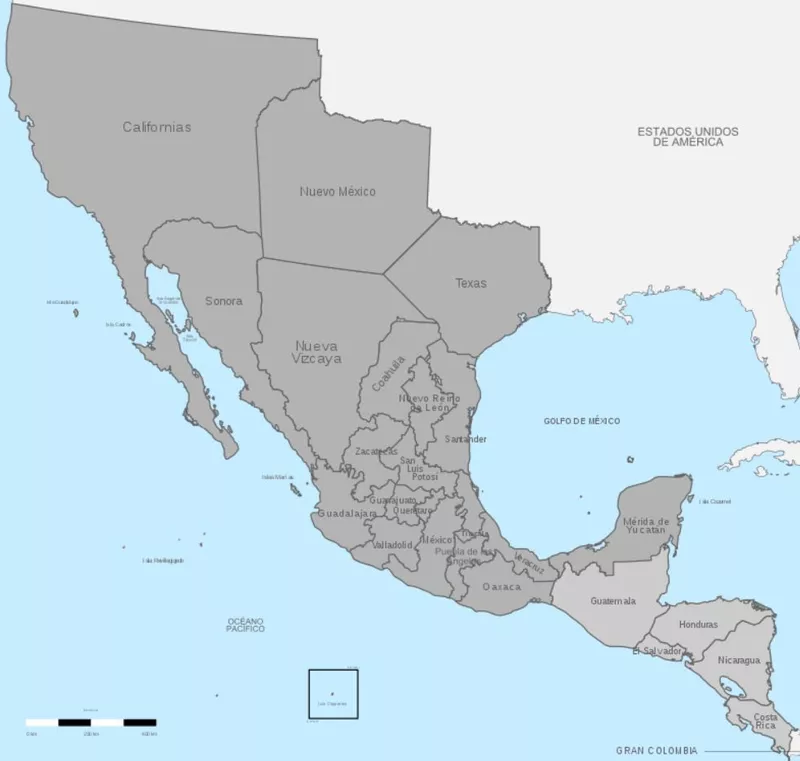
First Mexican Empire at its height Guggette / Wikipedia
Years: 1821-1823
Maximum land area year: 1821
Millions of square miles occupied: 1.71
Percentage of the world: 3.29
A Curious Empire
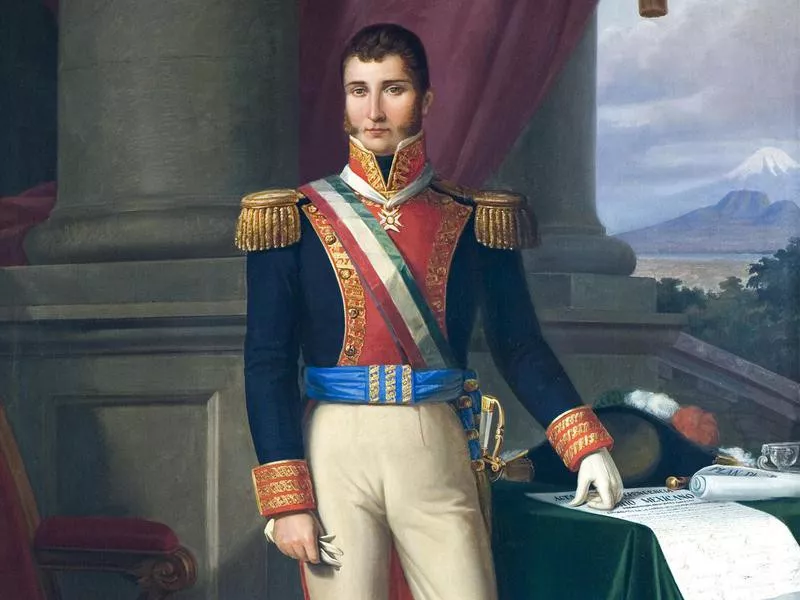
A portrait of Agustín de Iturbide. Primitivo Miranda / Wikpedia
The Mexican Empire was a curious empire, as it is both extremely short-lived and a constitutional monarch.
The empire came into being after the Mexican War of Independence concluded in 1821. Agustín de Iturbide, a Mexican military commander who took control of Mexico City from the Spanish and essentially won the war, was the empire's only monarch. He was elected a year after freeing the city by a congress who rushed him into emperorship due to his popularity.
His election was questionable, though, as congress did not have a quorum to establish him emperor. Regardless, they went through with it, but the nation was bankrupt and couldn't even afford to buy Iturbide a crown.
Iturbide clashed with congress, and by 1822, members of congress were already plotting to overthrow him. He abdicated his throne in 1823, ending the Mexican empire.
24. The Tibetan Empire
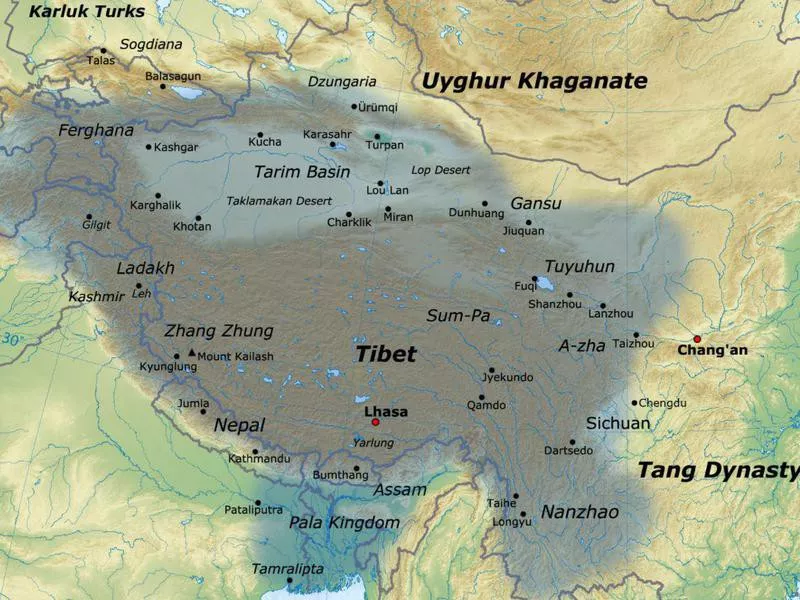
Map of the Tibetan Empire at its height. Jaierfv1212 / Wikipedia
Years: 618-842
Maximum land area year: 800
Millions of square miles occupied: 1.78
Percentage of the world: 3.41 percent
The Beginning of Buddhism in Tibet
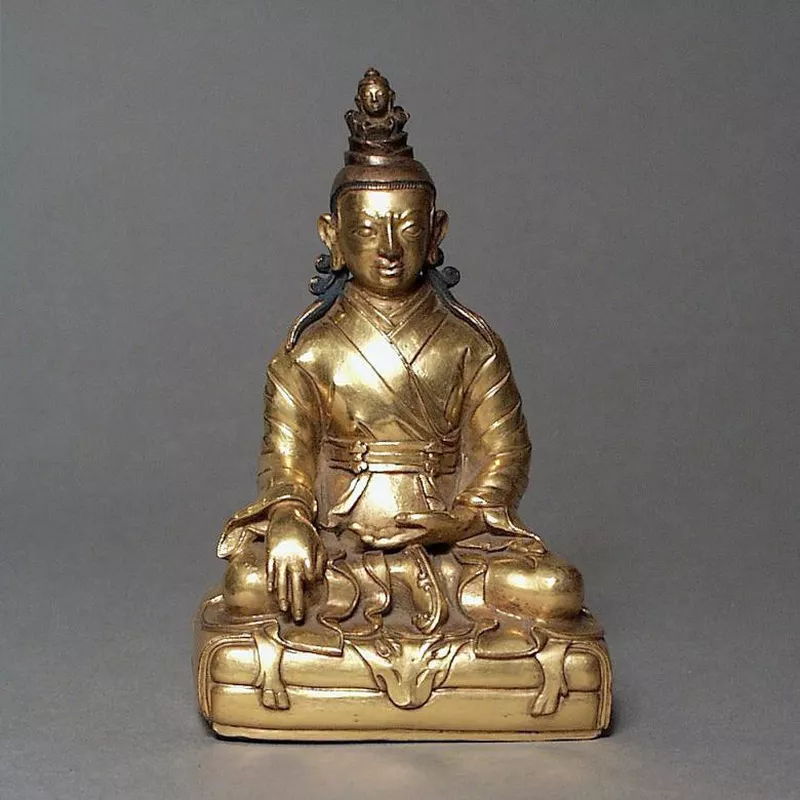
A statue of Songsten Gampo from the 17th century. Wikipedia
The Tibetan Empire was formed by Songsten Gampo, the 33rd king of Tibet and the man credited with establishing Tibetan script as well as helping usher in Buddhism in Tibet.
The Tibetan Empire was centralized on the Tibetan Plateau, where it proved to be difficult to take. The Tang Dynasty attempted to seize control of the Tibetan capital Lhasa but was forced to retreat due to the hostile environment.
At its height, the Tibetan Empire reached Mongolia and Bengal. It was during the 830s that the empire began to decline, as it was fraught with problems, like the collapse of the neighboring Uyghur Khaganate, and a civil war that lead to the Tibetan Era of Fragmentation.
23. Xin Dynasty
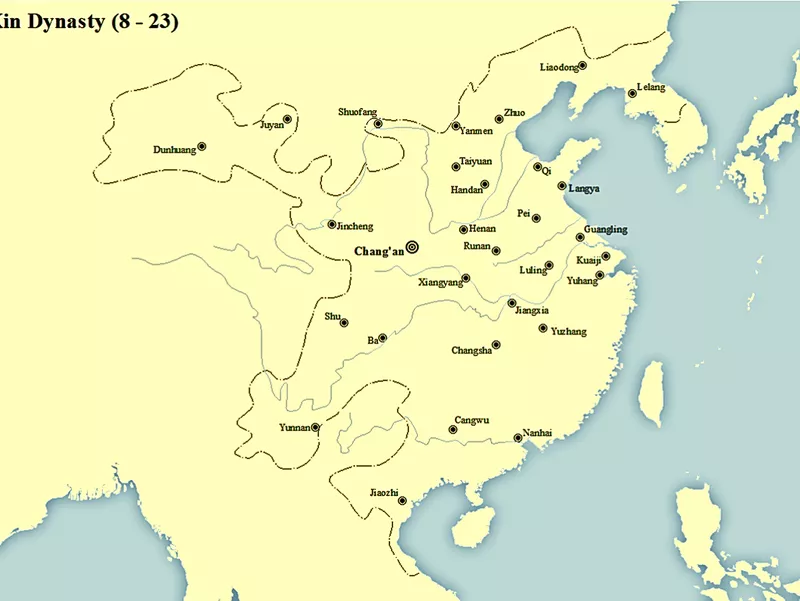
Map of the Xin Dynasty SS / Wikipedia
Years: 9-23
Maximum land area year: 10
Millions of square miles occupied: 1.81
Percentage of the world: 3.49 percent
The Xin Dynasty Was Very Short Lived
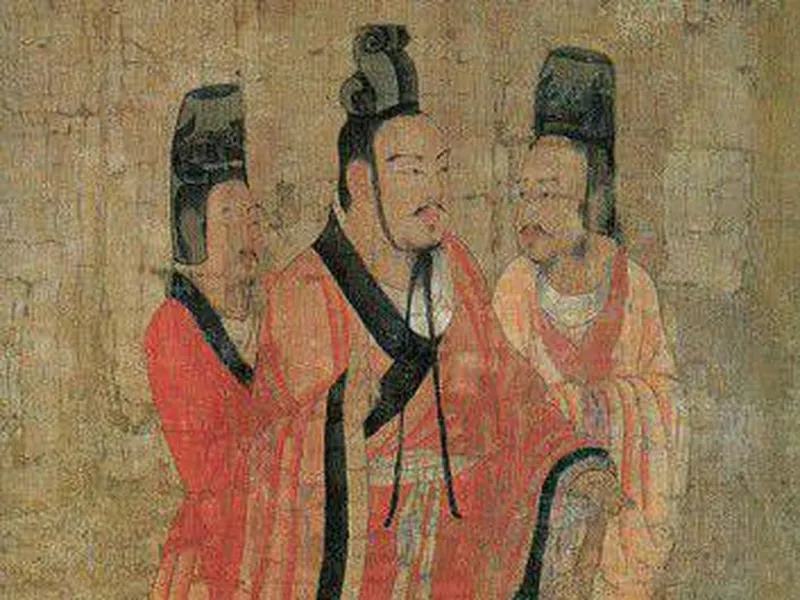
A possible portrait of Wang Mang. Smithsonian Mag
The Xin Dynasty was an interregnum Chinese dynasty that only lasted for 14 years. It was established by Wang Mang, a Han Dynasty consort and official who usurped the throne from the Emperor Ping of the Han Dynasty.
Wang's regime was ill-fated from the get-go, and his early efforts were undermined by natural disasters like floods, famines and locust plagues. That lost him the support of peasants, who turned into rebellious bandits and rose against Wang in 19 A.D.
Wang was killed in the resulting civil war, and the Xin Dynasty gave way to the Eastern Han Dynasty. When the rebels took the palace, he was enjoying himself in his harem with 39 of his wives and ladies.
22. The Roman Empire
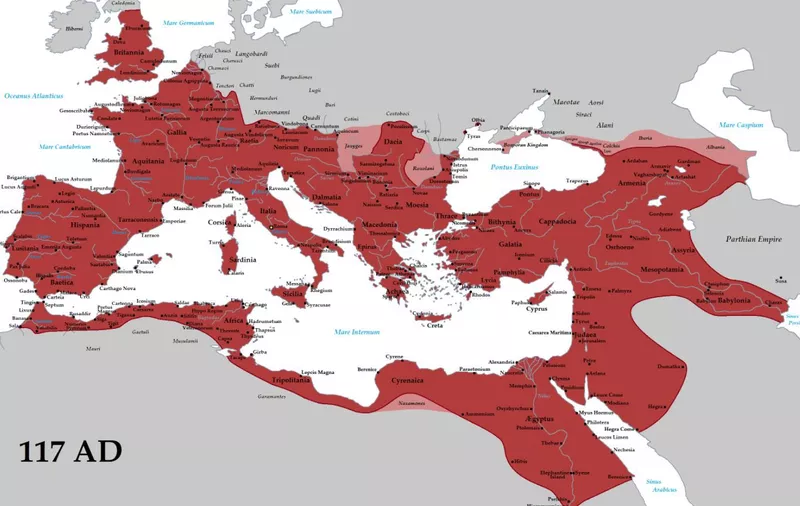
Map of the Roman Empire at its greatest extent in 117 A.D. Tataryn / Wikipedia
Years: 27 B.C.-476 A.D.
Maximum land area year: 117
Millions of square miles occupied: 1.93
Percentage of the world: 3.71
The Roman Empire Was The Longest-Running Empire in the World
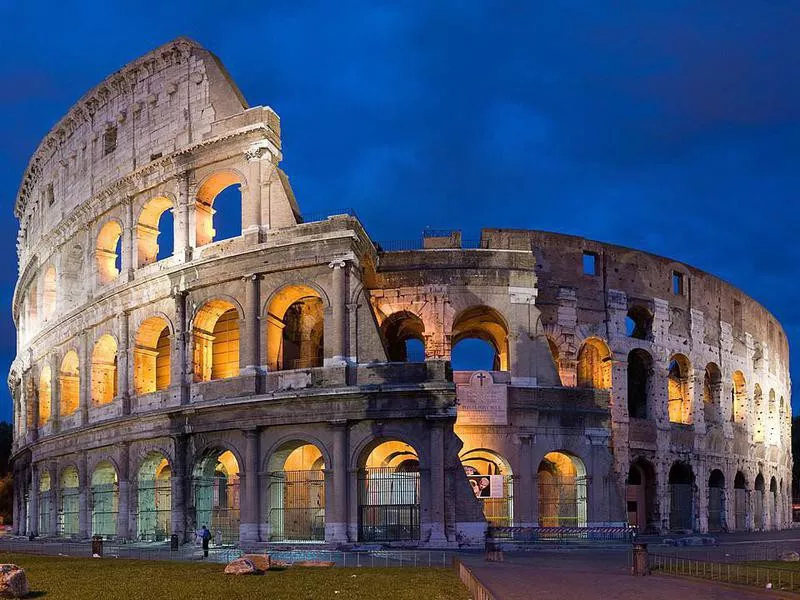
The famous Roman Colosseum. Diliff / Wikipedia
The Roman Empire was perhaps the greatest empire in all of history, and during its height, all roads did indeed seem to lead to Rome.
Rome was founded in 753 B.C. on April 21, or so it is commonly believed, and when the empire reached its height in 117, roughly 20 percent of the world's population fell under the Roman banner.
Ancient Rome was known for its conquests and the many, many things it contributed to modern society, including advances in warfare, art, literature, engineering and government.
Ancient Rome is an absolutely fascinating subject. We have an in-depth look into what it was like to live in ancient Rome for those who would like to step back in time.
21. Northern Yuan Dynasty
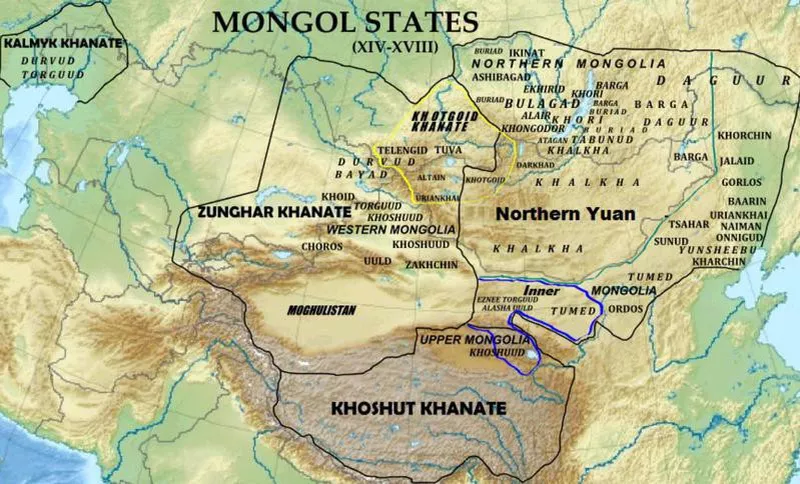
Map of the Northern Yuan Dynasty at its greatest extent. Khiruge / Wikipedia
Years: 1368-1635
Maximum land area year: 117
Millions of square miles occupied: 1.93
Percentage of the world: 3.71 percent
Mongols Adopted Buddhism During the Yuan Dynasty
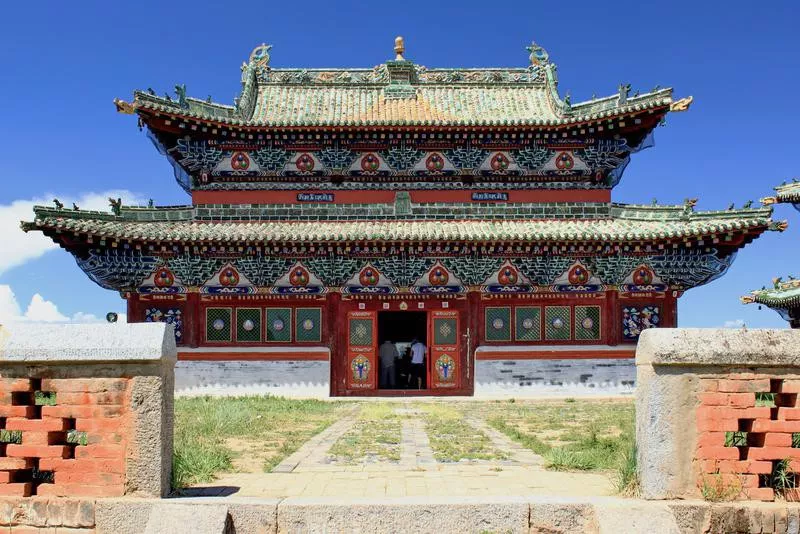
Marcin Konsek / Wikipedia
The Northern Yuan Dynasty succeeded the Yuan Dynasty and operated as a rump state — basically a much larger state that shrunk due to various wars and revolutions — following its collapse.
This period saw the reunification of the warring Mongols in the 1400s and fell by the 1630s with the death of Ligdan Khan, with Mongols forming into the four Khanates.
The Northern Yuan Dynasty also saw the adoption — and forced conversions — of Tibetan Buddhism in the 1570s. Pictured is the Erdene Zuu Monastery, the earliest surviving Buddhist monastery in Mongolia, which dates back to 1585.
20. Ottoman Empire
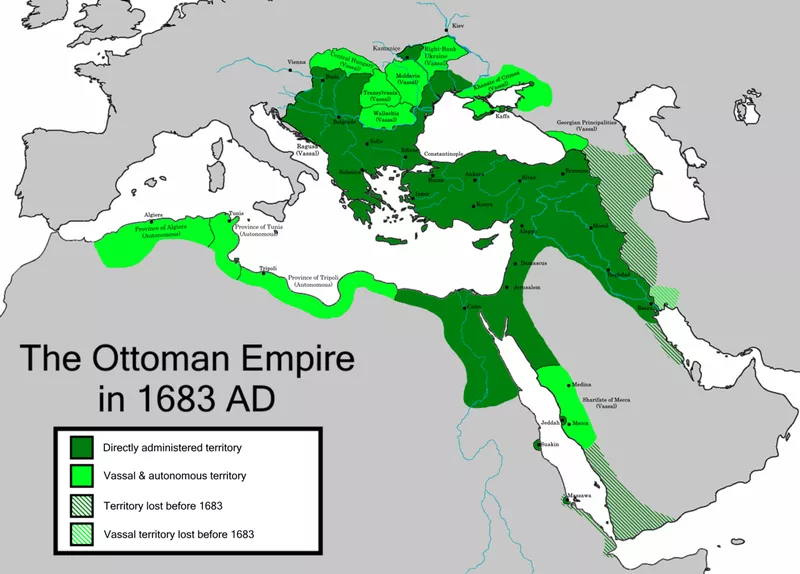
Chamboz / Wikipedia
Years: 1299-1922
Maximum land area year: 1683
Millions of square miles occupied: 20.1
Percentage of the world: 3.86 percent
One of the Longest Reigning Empires in History
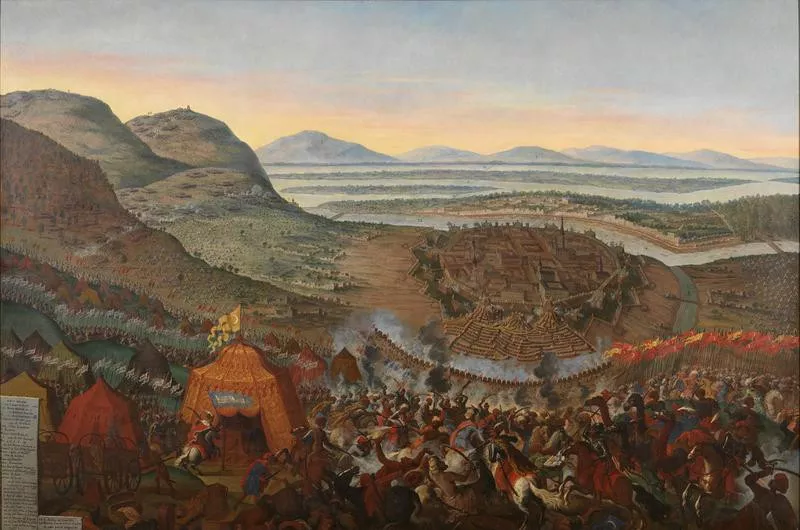
Frans Geffels / Wikipedia
The Ottoman Empire began in the small town of Sögüt in Bilecik Province, Turkey, in 1299. The early Ottomans expanded virtually nonstop and conquered the Balkans in the mid-14th century. By 1453, it had destroyed what remained of the Byzantine Empire.
At its height, the Ottoman Empire stretched from the majority of southeastern Europe to Vienna (pictured: "The Second Siege of Vienna" by Frans Geffels) and Greece, the Middle East and Algeria.
The Empire lasted 623 years until World War I when the Ottoman Empire joined Germany and was subsequently defeated. Its Middle Eastern territories were divvied up between the U.K. and France, and the empire was officially wiped out after the Turkish War of Independence.
19. Macedonian Empire
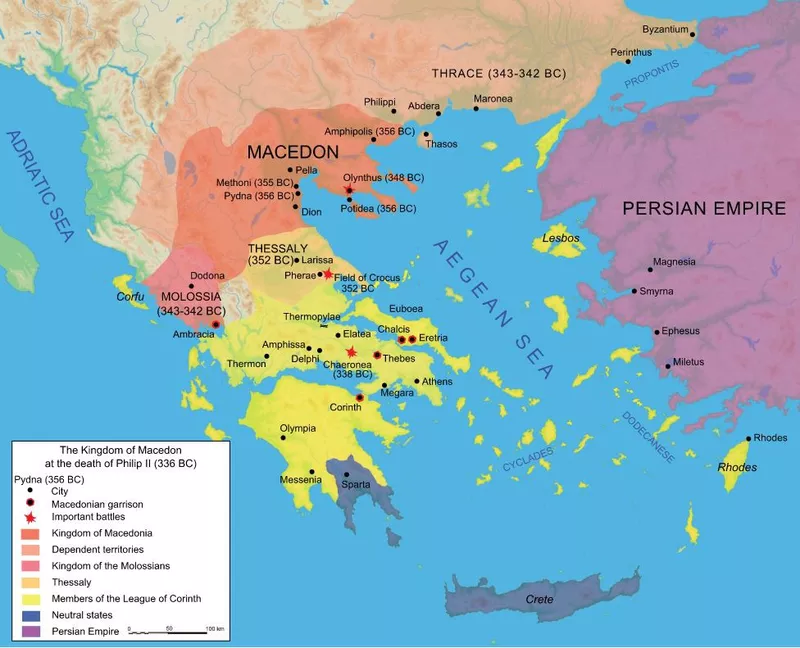
Map of the Kingdom of Macedonia during its height. Wikipedia
Years: 808-168 B.C.
Maximum land area year: 323 B.C.
Millions of square miles occupied: 2.01
Percentage of the world: 3.86 percent
Alexander the Great's Empire
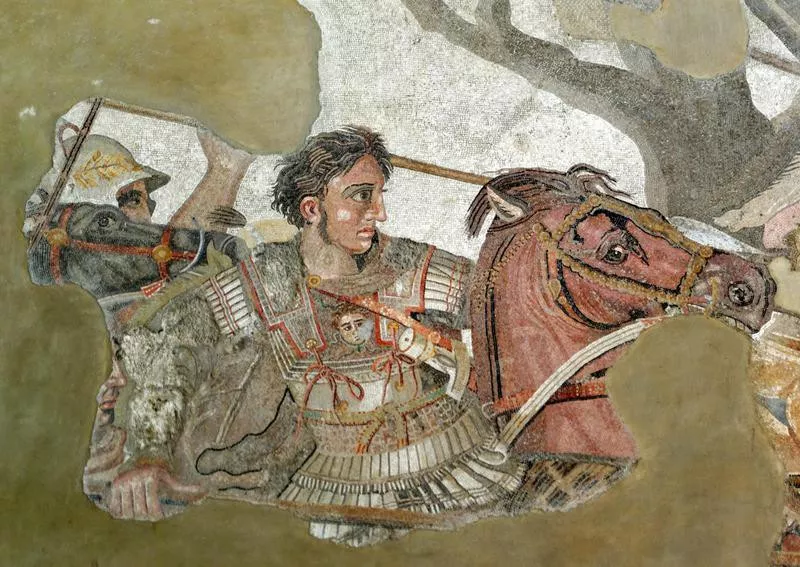
A detail of an ancient Roman mosaic depicting Alexander the Great at the Battle of Issus. Berthold Werner / Wikipedia
Macedonia existed for hundreds of years, but it was Alexander the Great who made an empire out of the ancient kingdom, if only for a brief time.
During his reign and until his death in 323 B.C., Macedonia comprised of Greece, Asia Minor, the Levant, Egypt, Mesopotamia, Persia and modern Pakistan. Advances in philosophy, engineering and science flourished and spread throughout the world.
Alexander's death resulted in a series of wars, marking the gradual decline of the Macedonian Empire.
18. Tang Dynasty
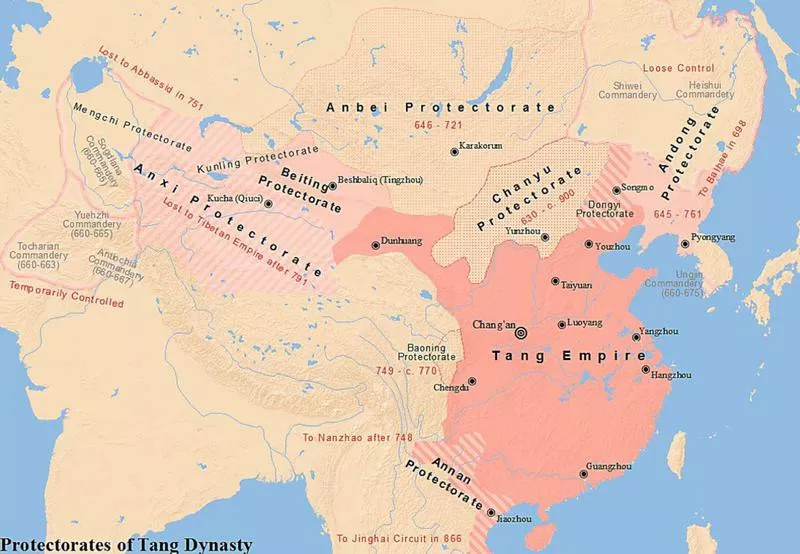
SY / Wikipedia
Years: 618-907
Maximum land area year: 715
Millions of square miles occupied: 2.12
Percentage of the world: 4.08 percent
The Tang Dynasty Was a Golden Age of Chinese Culture
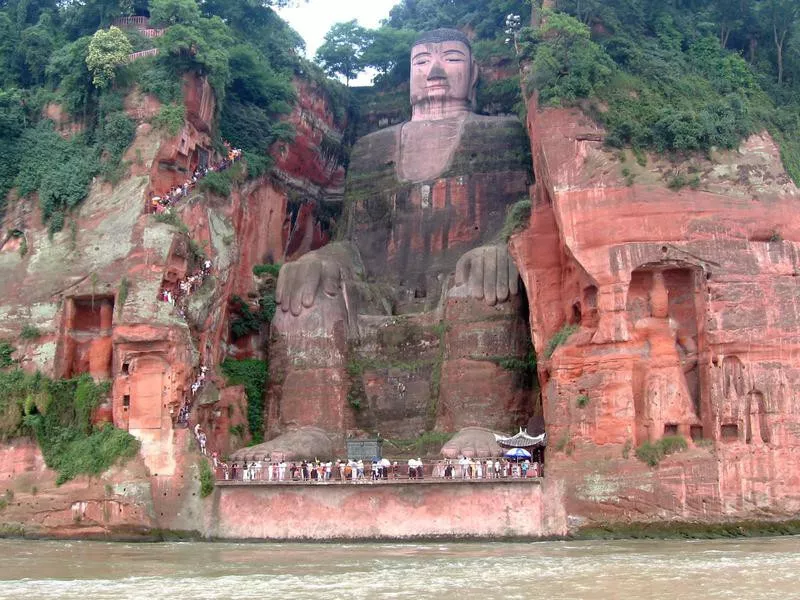
Ariel Steiner / Wikpedia
The Tang Dynasty was founded by Liu Yuan, who defeated the preceding Sui Dynasty 617.
In 712, Emperor Xuanzong came to power. A lover of the arts and humanities, Xuanzong embraced Buddhists and Taoists in his court and created an academy for poets and musicians. The humanities flourished during this time, and over 48,900 poems were preserved, written by over 2,000 poets. Woodblock printing was developed during the early Tang era as well.
Xuanzong ruled for 44 years and ushered in a golden age of low inflation and progressive idelas (he even abolished the death penalty).
The Tang Dynasty fell due to rebellions and mass political assassinations, including the Sweet Dew incident, where 1,000 government officials were executed. In 907, the Tang Dynasty was gone and the Five Dynasty period began.
17. Achaemenid Empire
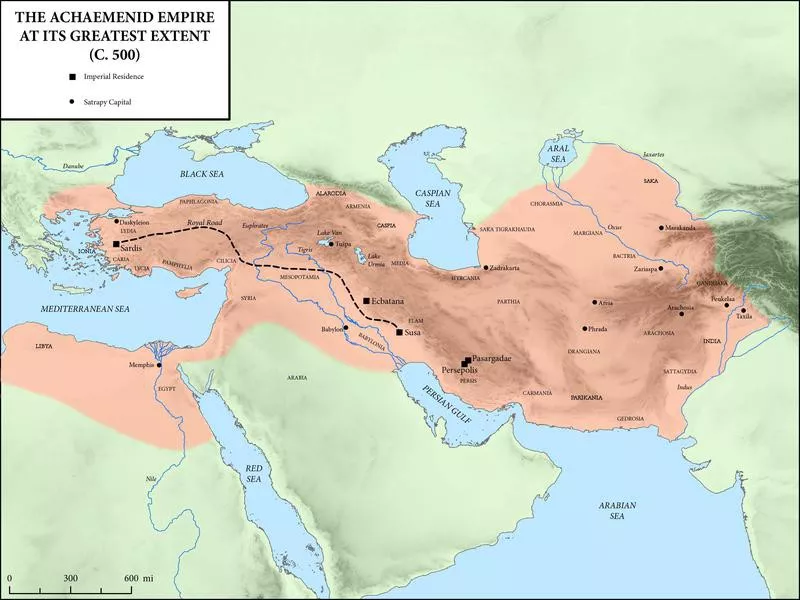
Mossmaps / Wikpedia
Years: 530-330 B.C.
Maximum land area year: 500 B.C.
Millions of square miles occupied: 2.32
Percentage of the world: 4.08 percent
The Achaemenid Empire Conquered Ancient Greece
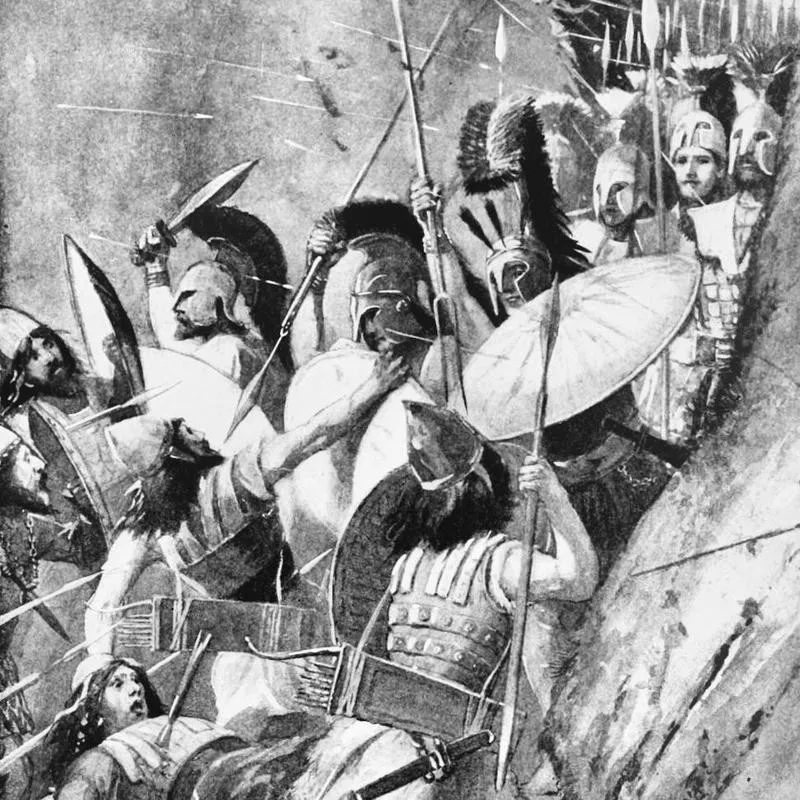
John Steeple Davis / Wikipedia
Also known as the First Persian Empire, the Achaemenid Empire was the largest the world had ever seen during its height in 550 B.C. Founded by Cyrus the Great, the Achaemenid Empire stretched from Egypt to Central Asia.
Much of what we know about the Achaemenid Empire comes from the writings of the ancient Greek historian Herodotus. One of the most famous battles fought during this time was the Battle of Thermopylae, where a vastly outnumbered army of Spartan and Greek forces led by King Leonidas held off thousands of Persians at the narrow pass of Thermopylae and inflicted heavy casualties.
Xerxes I, then ruler of the Achaemenid Empire, was estimated to have up to 300,000 men, while Leonidas commanded about 7,000. But the Greeks and Spartans were betrayed by a fellow Greek, who showed Xerxes' army another path around the pass. Thousands of Greek forces were crushed or surrendered, leaving only Leonidas and his 300 bodyguards and 1,100 Boeotians to defend the pass, which they did until their death. You probably know this story from the movie "300."
The Achaemenid Empire was conquered by Alexander the Great by 330 B.C.
16. The Golden Horde Khanate
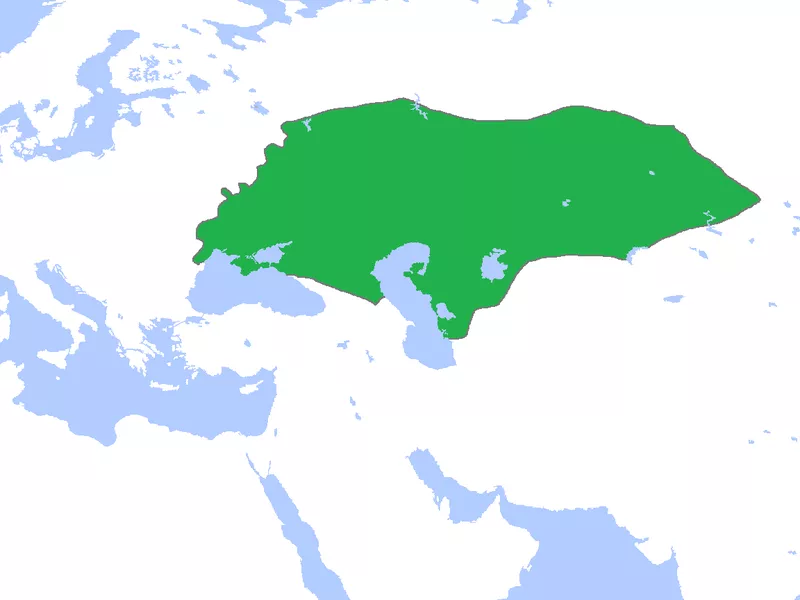
Gabaool / Wikipedia
Years: 1242-1502
Maximum land area year: 1310
Millions of square miles occupied: 2.32
Percentage of the world: 4.45 percent
The Rule of the Golden Horde
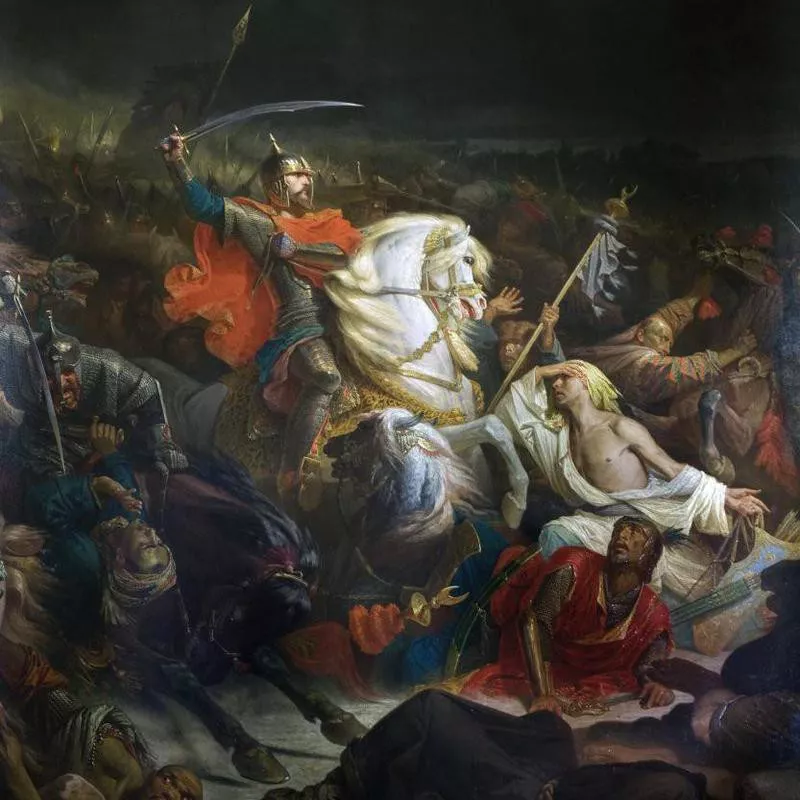
Adolphe Yvon / Wikipedia
Batu Khan, grandson of Genghis Khan, founded the Golden Horde, which conquered and ruled Russia for over 200 years. When they crushed Russia in 1240, the horde marched west, tearing into and over Europe, where it invaded Poland and annihilated the Kingdom of Hungary, slaughtering as much as a quarter of its population. Europeans nicknamed the Mongols the Tartars because they appeared to be demons from Tartarus (aka hell).
The Golden Horde and gradual decline of the Mongol Empire began in the 14th century due to the ravages of the Black Death and civil war. In 1380, the Russians won their first victory over the Mongols at the Battle of Kulikovo, marking a turning point of the Mongols' bloody grip over Russia.
Pictured is a painting of Dmitry Ivanovich Donskoy, Prince of Moscow, who led the Russians into victory during the Battle of Kulikovo.
15. Rashidun Caliphate
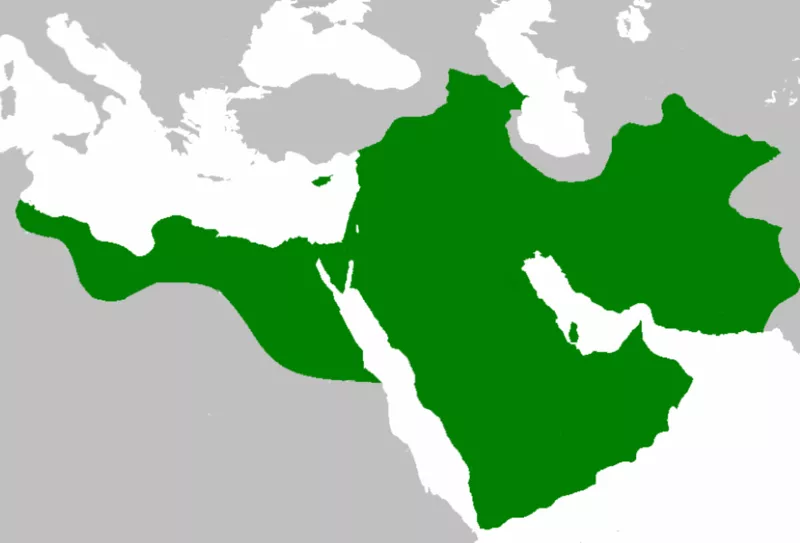
Rashidun Caliphate at its peak. Mohammad adil / Wikipedia
Years: 632-661
Maximum land area year: 655
Millions of square miles occupied: 6.4
Percentage of the world: 4.75 percent
The First of the Four Caliphates
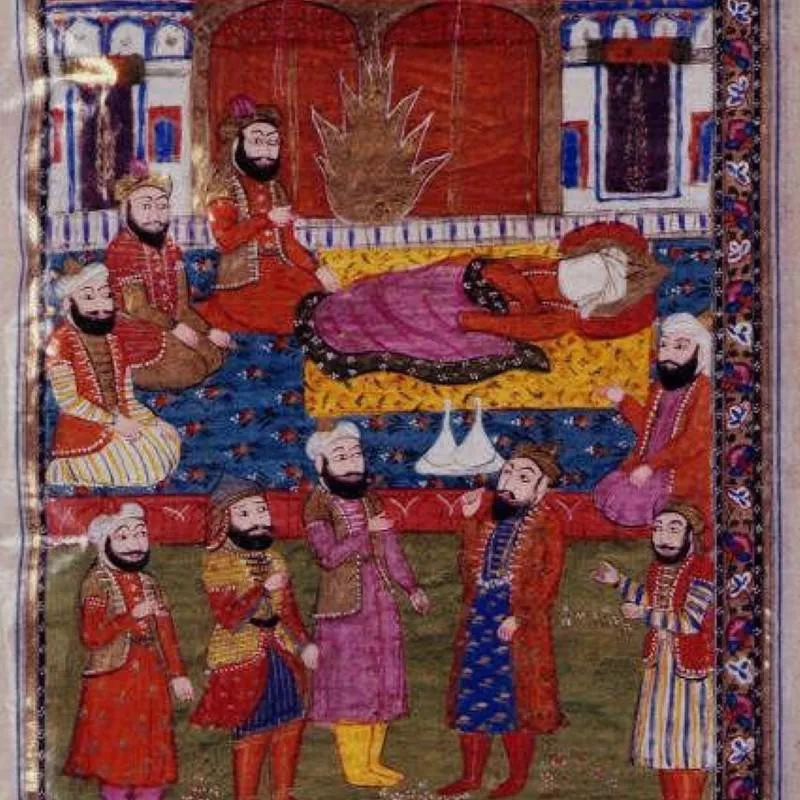
"Ali With the Dying Abu Bakr." A miniature painting from a 19th-century manuscript of Hamla-i Haydari, a poetical account of the life of Ali by Muhammad Rafi Bazil. Muhammad Rafi' Bazil / Wikiepdia
The Rashidun Caliphate was the first of four caliphates (government under a caliph, or spiritual leader of Islam) that were established following the death of the prophet Muhammed, who died in 632.
Abu Bakr became the first Rashidun leader and launched the Ridda Wars, which crushed rebelling Arabians who refused to see Bakr as their ruler after Muhammad died. He took the entire Arabian Peninsula but only ruled for 27 months, dying of illness in 634.
Over the course of 25 years, and subsequent caliphates, Mesopotamia, the Levant, parts of Anatolia and the Sasanian Empire came under the Rashidun Caliphate's rule.
The pictured fresco is of Bakr dying while Ali ibn Abi Talib — who would become the fourth caliphate — looks on.
14. Ming Dynasty
Years: 1368-1644
Maximum land area year: 1450
Millions of square miles occupied: 2.51
Percentage of the world: 4.82 percent
Rise and Fall of the Ming Dynasty
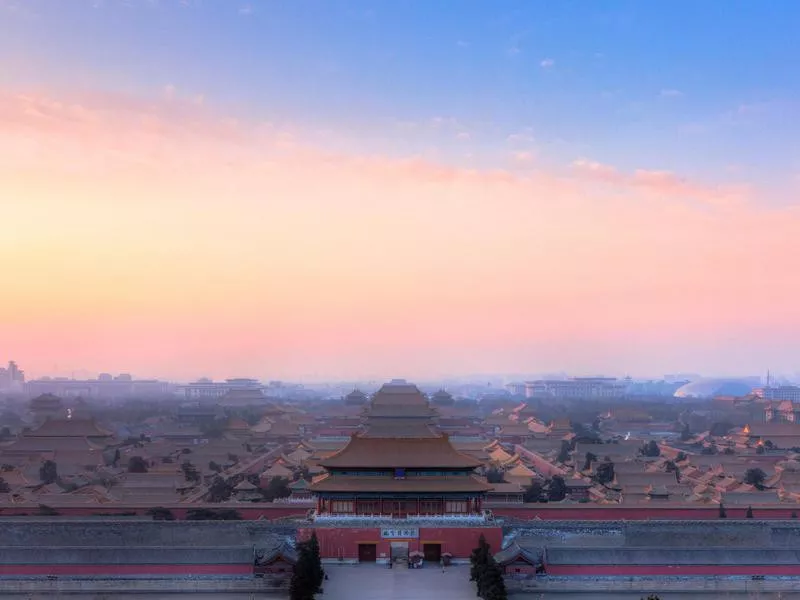
The Forbidden City in Beijing, China. Pixelflake / Wikipedia
After Honqwu Emperor Taizu, or Zhu Yuanzhang, defeated the Mongol-led Yuan dynasty (they're a bit further down this list), Yuanzhang established the Ming dynasty in 1368.
Yuanzhang ruled for 30 years in relative religious tolerance but not without copious amounts of murder. The emperor killed over 70,000 people whom he believed to oppose him, from high-level government officials to peasants. He also established a standing army of over one million troops.
After Yuanzhang's death, there was a civil war, but following that, a great expansion in trade with India and African countries, which grew the Ming dynasty's power. Eventually, constant war in Korea, Japan and against the ceaseless raids of the Mongols sapped the dynasty's power, and it collapsed in 1644.
One of the Ming dynasty's most notable accomplishments was the establishment of the Forbidden City, the largest palace in the world, which stretches over 180 acres.
13. Eastern Han Dynasty
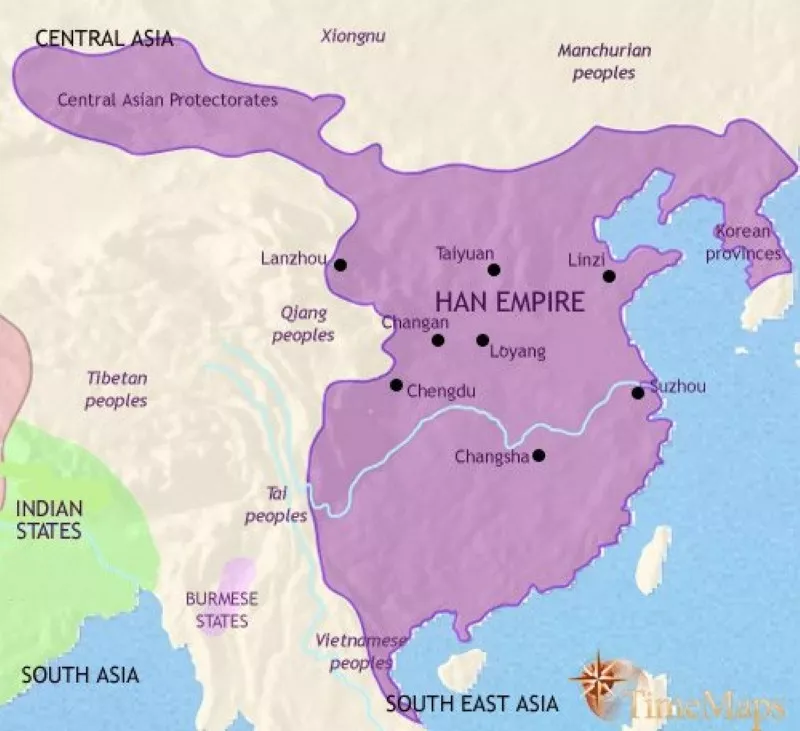
Map of the Eastern Han dynasty. Time Maps
Years: 202 B.C-220 A.D.
Maximum land area year: 100
Millions of square miles occupied: 2.51
Percentage of the world: 4.82 percent
Eastern Han Dynasty Ruled for 120 Years
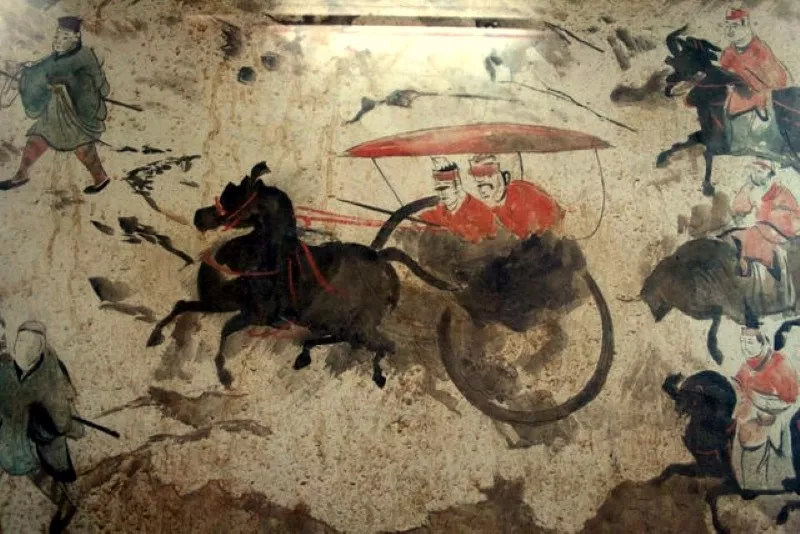
Late Han Fresco from the Luoyang Ancient Tombs Museum in Luoyang, China. Gary Lee Todd / Wikipedia
The Eastern Han dynasty (also known as the Later Han dynasty) began after Wang Mang, the last emperor of the Western Han dynasty, was beheaded following an insurrection, and Liu Xiu took the mantle of Emperor Guangwu.
Xiu was an extraordinary strategist who toppled oppositional rebellion warlords throughout China, growing the Eastern Han dynasty as he did. He didn't put their heads on pikes, either, opting instead to spare them.
He united much of China during his reign and established the Eastern Han dynasty, which lasted for roughly 120 years. It ended after the Yellow Turban Rebellion and the empire's splintering by the Warlord Dong Zhuo.
12. Iberian Union
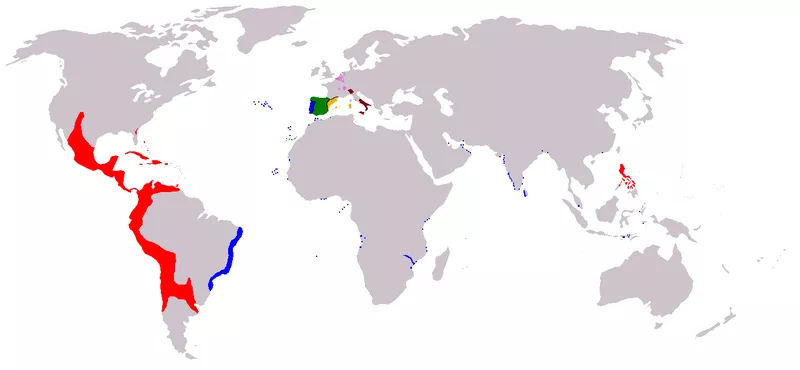
Iberian Union map. Trasamundo / Wikipedia
Years: 1580-1640
Maximum land area year: 1640
Millions of square miles occupied: 2.51
Percentage of the world: 4.82 percent
Spain and Portugal Briefly Ruled as One
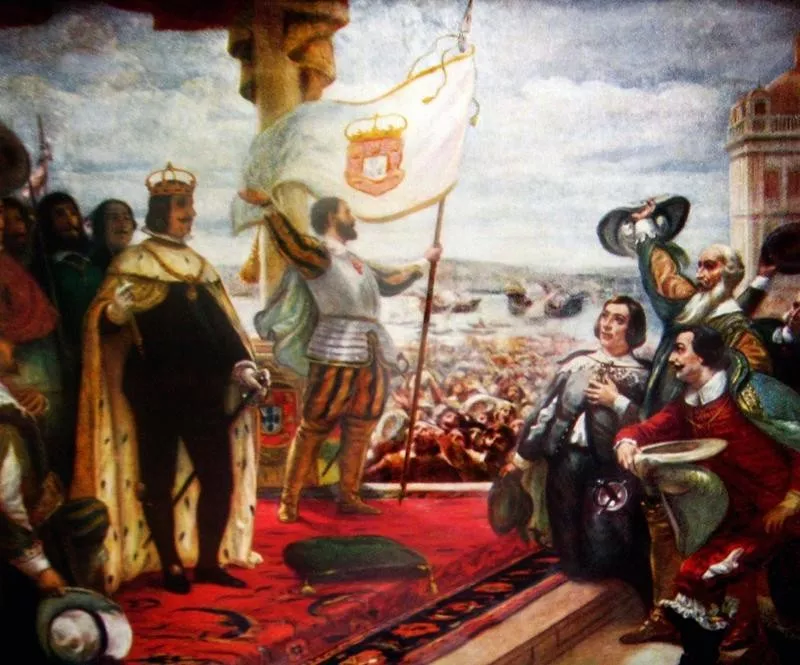
"The Acclamation of King John IV" by Veloso Salgado, 1908. Veloso Salgado / Wikipedia
The Iberian Union was a dynastic union — that is, a two-state federation that governs under the same dynasty while still keeping their respective laws and boundaries — between the Kingdom of Spain and the Kingdom of Portugal under the Spanish Crown.
Long story short, the King of Portugal, Sebastian I, died in 1578, but had no direct heirs, prompting a succession crisis.
Philip II of Spain ultimately gained control of Portugal and united the two countries under the Iberian Union, which lasted 60 years.
11. Empire of Japan

The Empire of Japan by 1942. MapScaping / Twitter
Years: 1868-1947
Maximum land area year: 1942
Millions of square miles occupied: 3.285
Percentage of the world: 6.32 percent
The Japanese Empire Changed Modern History

Fifty thousand students in and around Tokyo undergo rigorous training for war in November 1936. Some are equipped with bicycles to facilitate quick arrival in Tokyo. AP Photo
The Japanese Empire, which joined the Axis powers, was a terrifying force. Under the emperor Hirohito, Japan attacked pretty much all of its neighbors and perpetrated numerous war crimes against China during the Second Sin-Japanese War, including the Nanjing Massacre, in which several hundred thousand Chinese civilians and soldiers were brutally murdered.
The empire began to fall after the Battle of Midway, which shifted the tides of war in the Allies' favor during World War II. It all but completely fell on Aug. 15, 1945, after the United States dropped atomic bombs on Hiroshima and Nagasaki, killing roughly 190,000 Japanese men, women and children.
10. Empire of Brazil
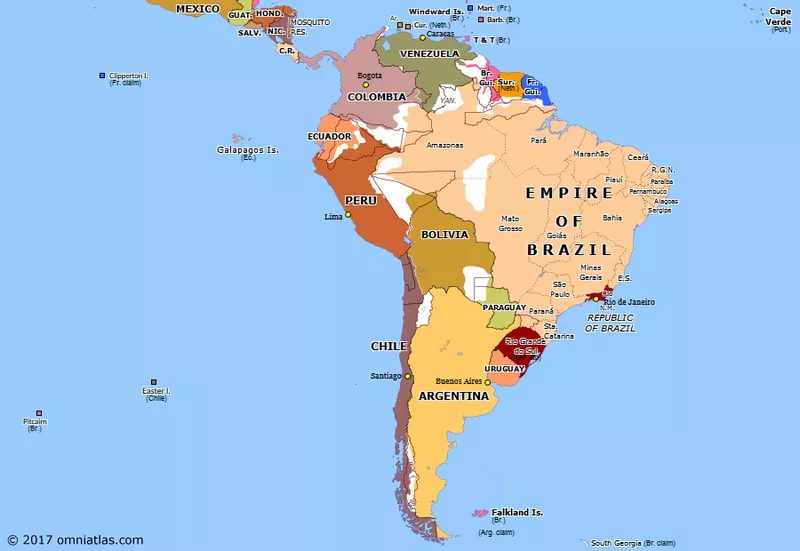
Map of Empire of Brazil during its height. Omni Atlas
Year: 1822-1889
Maximum land area year: 1889
Millions of square miles occupied: 3.22
Percentage of the world: 6.19 percent
The Empire of Brazil Didn't Last Long
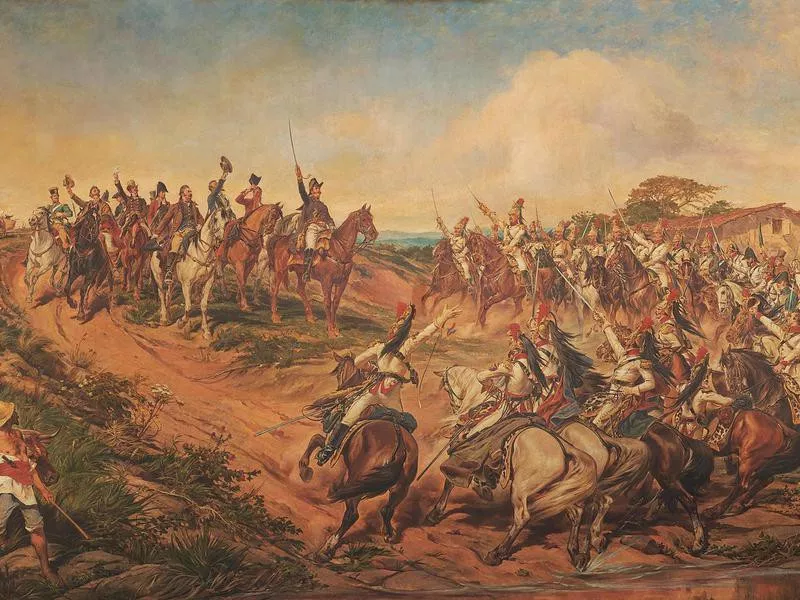
"Independence or Death" by Pedro Américo, 1888. Wikipedia
The Empire of Brazil was a state that encompassed what is modern-day Brazil and Uruguay, and it lasted for 67 years.
The country was founded by Pedro I, who sided with Brazil in the country's rebellion against Portugal in 1822.
The Empire of Brazil was fraught with inner-government turmoil and, after just nine years of being declared emperor, Pedro I abdicated the throne in 1831, leaving it for his 5-year-old son, Pedro II. While there was an initial crisis during this period, Pedro II grew to become a very good king and the Empire of Brazil hit its golden age in 1870.
However, Pedro II grew increasingly cynical and tired of ruling, and his heir, his eldest daughter, Isabel, didn't want to bother with becoming monarch. The monarchy gradually lost its power and in 1889, Pablo II and the monarchy were overthrown in a coup known as the Proclamation of the Republic.
9. Xiongnu Empire
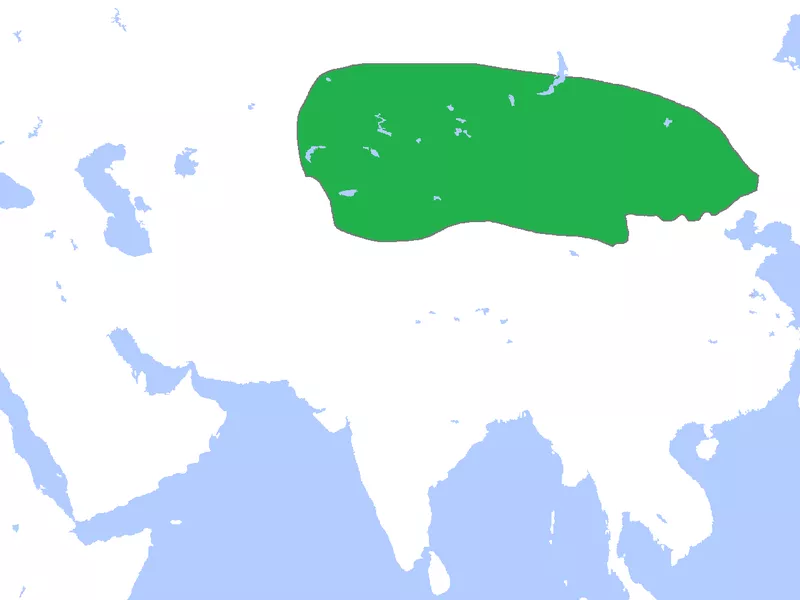
Xiongnu Empire before the Han-Xiongnu War. Gabagool / https://en.wikipedia.org/wiki/Xiongnu#/media/File:XiongnuMap.png
Years: 209 B.C.-460
Maximum land area year: 176 B.C.
Millions of square miles occupied: 3.47
Percentage of the world: 6.68 percent
The Xiongnu Were the Reason for the Great Wall of China
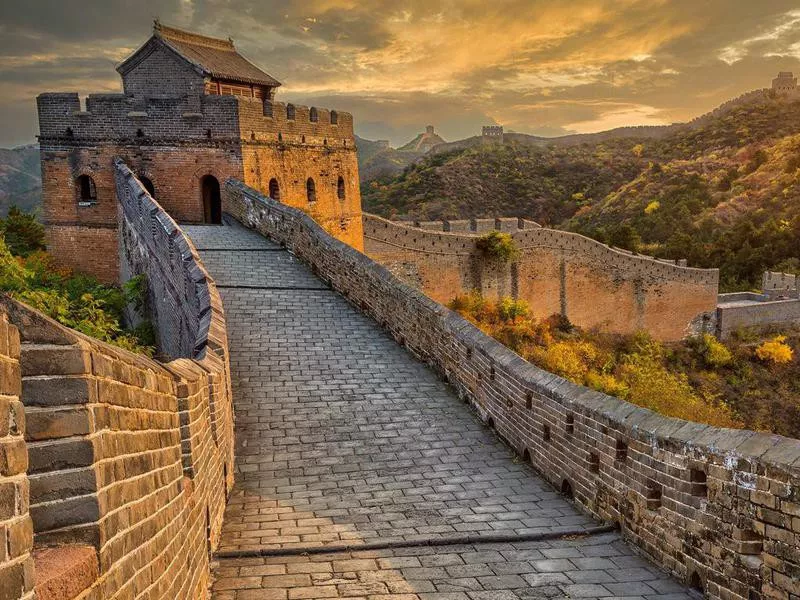
Getty Images
The Xiongnu were a nomadic group from Central Asia that raided China so badly that the first Qin Dynasty emperor ordered the building of great fortifications to the country's north — the very beginning of the Great Wall of China.
The Xiongnu existed on the ancient eastern Eurasian Steppes from 209 B.C. into the fifth century. The Xiangnu Dynasty fell after the Xiongnu prince Liu Yao was captured in battle and executed in 329.
8. Yuan Dynasty
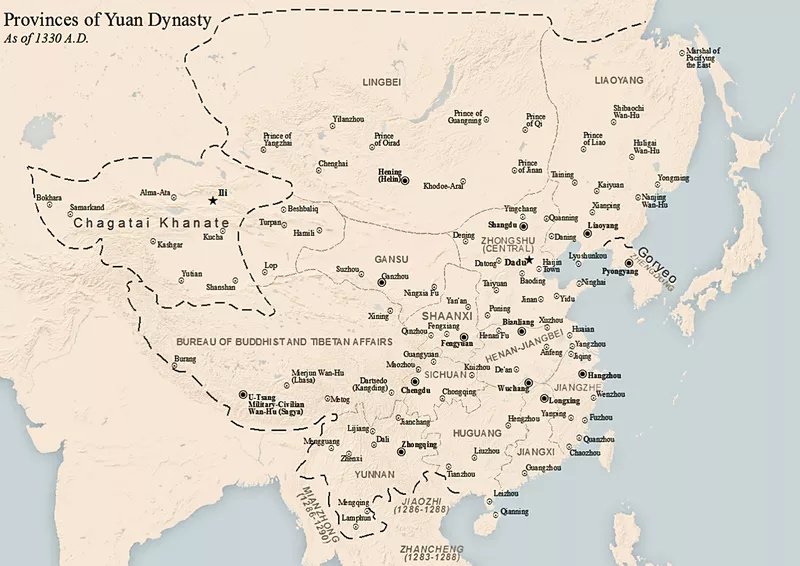
Map of the Yuan dynasty in 1330 A.D. SY / Wikipedia
Years: 1271-1368
Maximum land area year: 1310
Millions of square miles occupied: 4.25
Percentage of the world: 8.16 percent
The Mongol Empire Turned into the Yuan Dynasty
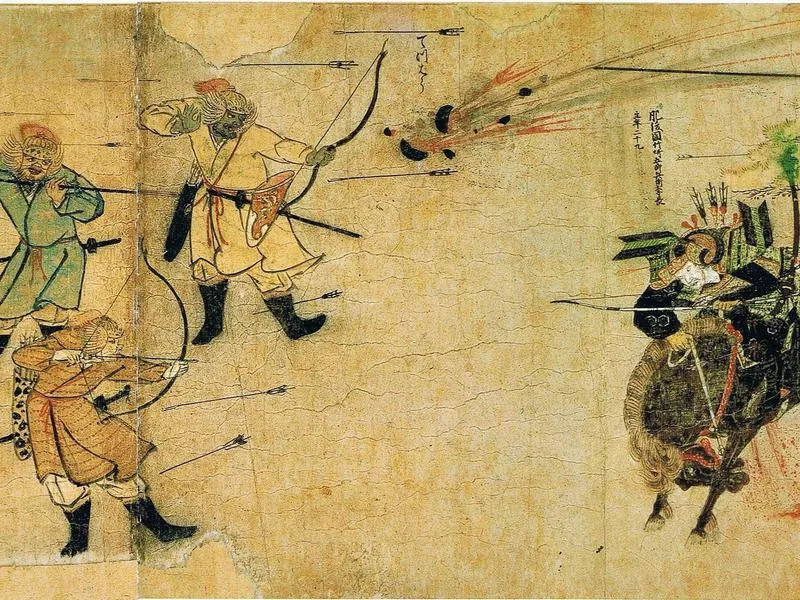
Moko Shurai Ekotoba was a set of two Japanese illustrated handscrolls (emakimono) composed between 1275 and 1293. This version shows the samurai Suenaga under fire from Mongol arrows and bombs. Wikipedia
The Yuan dynasty succeeded the Mongol Empire and was founded by Kublai Khan. It was an extension of the Mongol Empire, which had recently splintered into four powers.
The Yuan dynasty ruled over what is now Mongolia, Korea and most of modern-day China. The dynasty began in 1271 and lasted until 1368, when the empire's lands were beleaguered by natural disasters, short-reigning leaders, a weakened army and ineffective emperors which led to populist uprisings.
7. Umayyad and Abbasid Caliphate
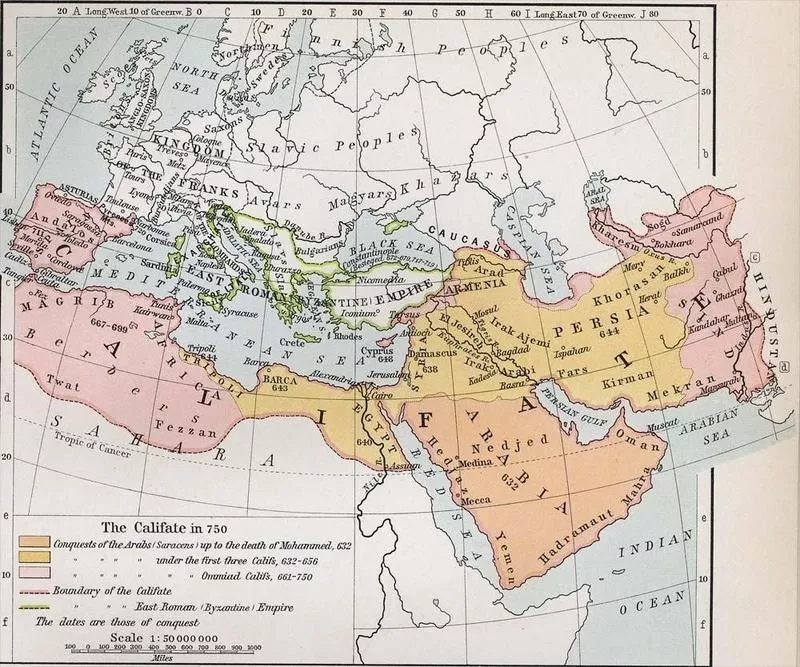
The expansion of the Muslim Caliphate until 750. "Historical Atlas" by William R. Shepherd / Wikipedia
Years: Umayyad — 661-750; Abbasid — 750-1258, 1261-1517
Maximum land area year: Umayyad — 720, Abbasid — 750
Millions of square miles occupied: 4.29
Percentage of the world: 8.24 percent
Modern Quran Came from the Third Caliphate
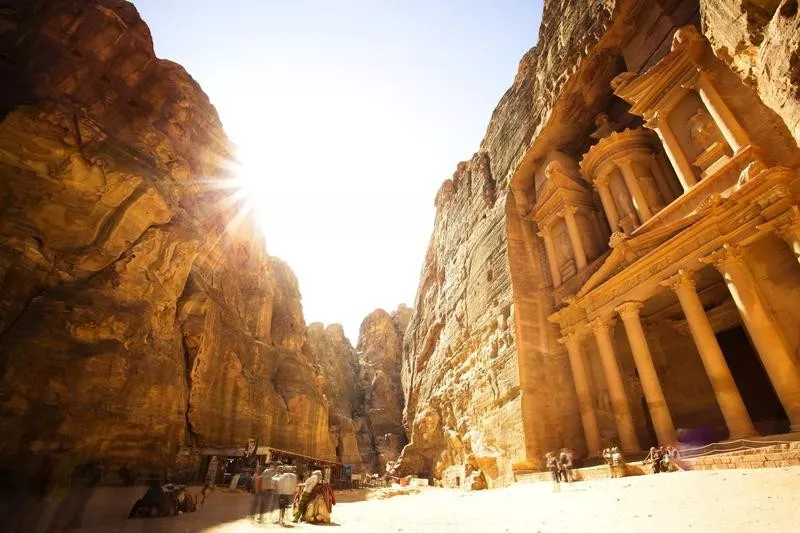
A rock-cut temple in Petra, Jordan. Getty Images
The Umayyad and Abbasid Caliphates were the second and third caliphates following the Rashidun Caliphate. We're combining them because they both have the same landmass conquered, although they are two disparate dynasties.
Pictured here is the ancient city of Petra, located in Jordan, which has incredible rock-cut buildings. It shows the Al-Khazneh, a temple carved out of sandstone rock. Under the Umayyad Caliphate, this ancient city began to die. Under the Abbasid Caliphate, whatever remained of it after earthquakes was neglected, and the city almost entirely disappeared from history until the early 1800s.
Uthman ibn Affan, the third Caliphate, put together the standard version of the Quran.
6. Second French Colonial Empire
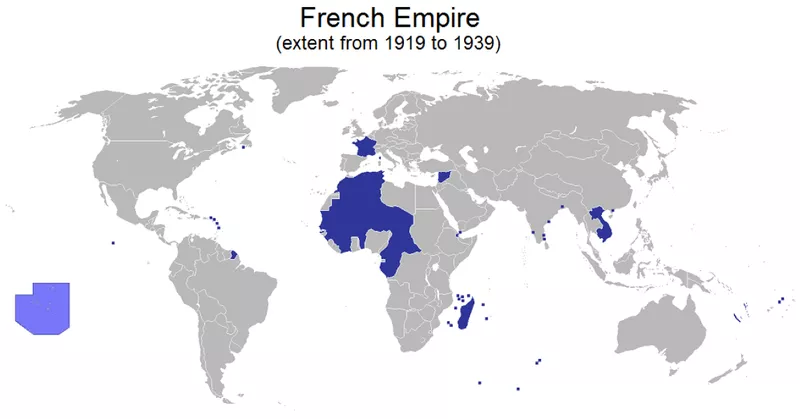
Map of the second French colonial empire. Rosss / Wikipedia
Years: 1534-1980
Maximum land area year: 1920
Millions of square miles occupied: 4.44
Percentage of the world: 8.53 percent
The French Conquered Much of Africa
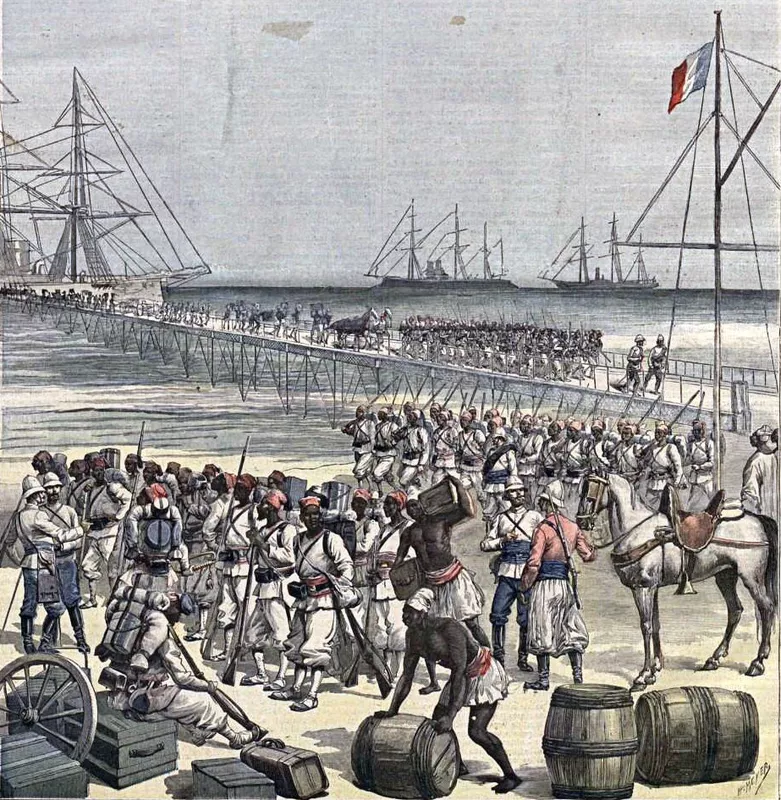
Disembarkation of French Troops in Cotonou, present-day Benin, with Senegalese soldiers in front row in 1892. Le Petit Journal / Wikipedia
The Second French Colonial Empire began in 1830 with the Invasion of Algiers.
Napoleon III greatly expanded the French empire overseas, and by the 1910s, France controlled nearly half of Africa. By 1931, the French had an imperial population of 64.3 million.
The second colonial empire began to fall during the 1940s. During World War II, decolonization movements and in Algeria were crushed by the French settlers, who slaughtered thousands in Setif and Guelma on the same day that Germany surrendered. This brutal response by the French sowed the seeds for the Algerian War of Independence, which would end the second French colonial empire by the 1960s.
5. Spanish Empire
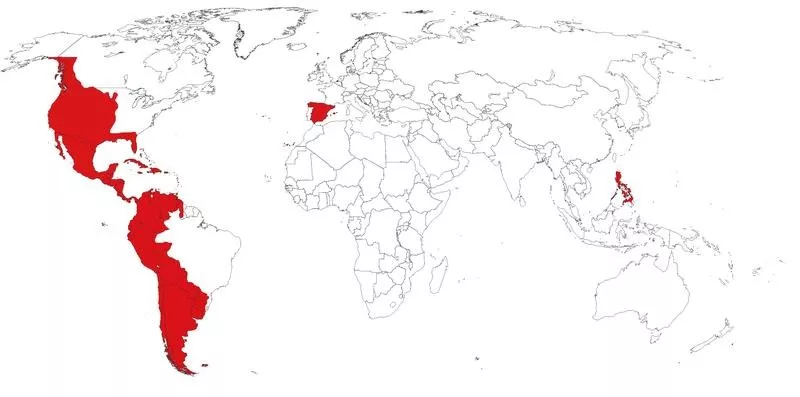
The Spanish Empire at its height. The Dialogue / Reddit
Years: 1492-1976
Maximum land area year: 1810
Millions of square miles occupied: 5.29
Percentage of the world: 10.17 percent
The Sun Never Set on the Spanish, Until It Did
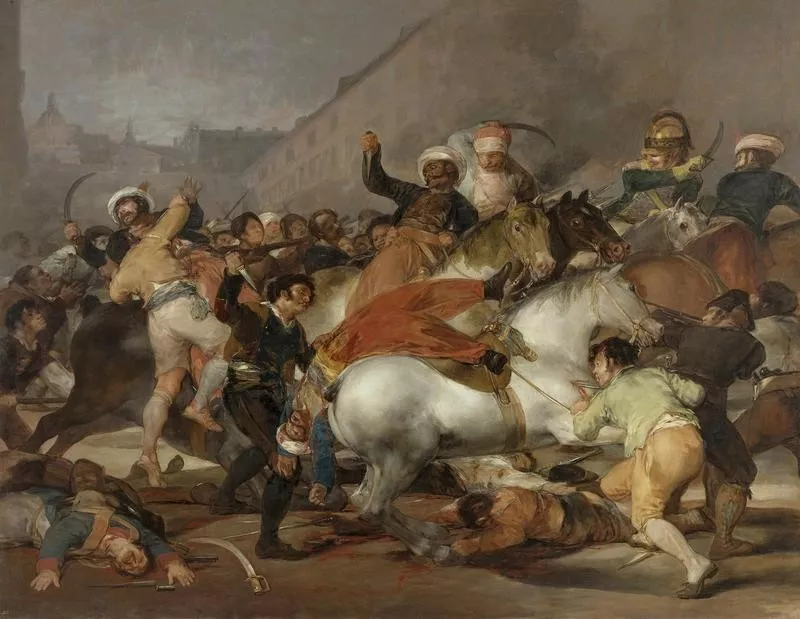
"The Charge of the Mamelukes" by Francisco de Goya. Francisco de Goya / Wikipedia
For three centuries, the Spanish Empire spanned so much of the globe that it was known as "the empire on which the sun never sets" due to one of its territories always being in daylight.
But its power began to wane by the end of the 17th century due to a series of lackluster rulers. Its empire was so extensive, though, that it required quick industrialization to keep up with the times. Instead, it languished, while other European powers caught up and surpassed Spain in the early 1880s.
4. Qing Dynasty
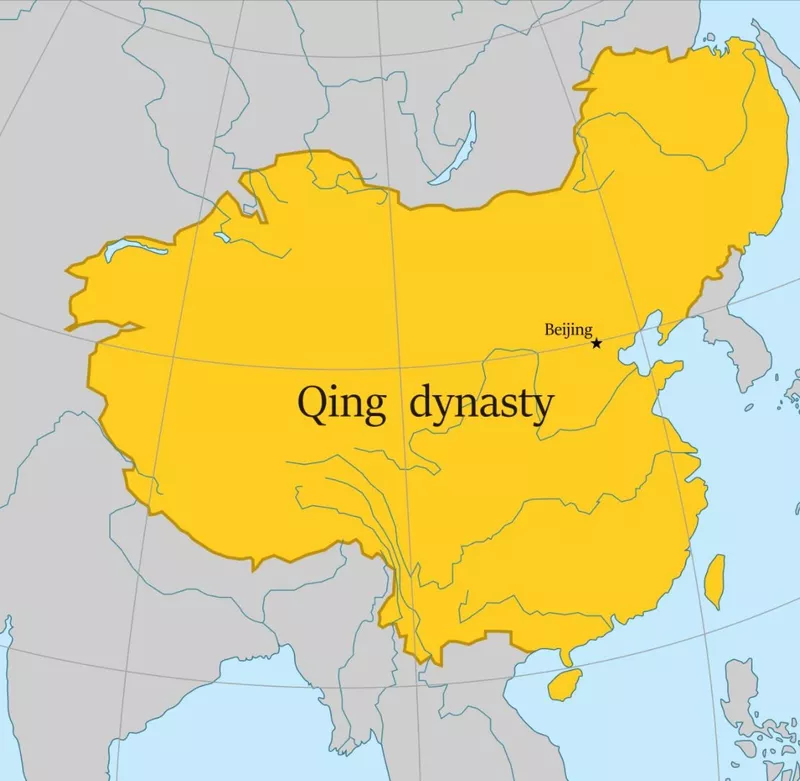
Map of the Qing dynasty in 1765. Samhanin / Wikiepdia
Years: 1636-1912
Maximum land area year: 1790
Millions of square miles occupied: 5.68
Percentage of the world: 10.91 percent
The Qing Dynasty Was the Last Imperial Dynasty of China
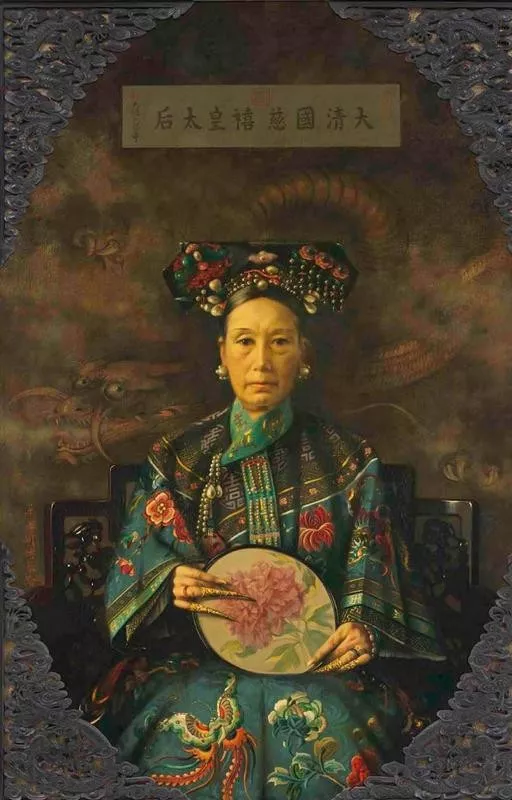
Painting of Empress Dowager by Hubert Vos, 1905. Dowager ruled the Qing dynasty from 1861 until 1908. Hubert Vos / Wikipedia
The Qing dynasty was the last imperial dynasty of China, lasting from 1636 until 1912. It was at its height in the late 18th century, with China's population doubling that of the Ming dynasty and a high level of education throughout the land.
The Qing dynasty flourished in the arts, and the commercialization of high-quality porcelain became a valuable trade asset that bolstered the empire's economy.
The Opium Wars of the mid-19th century weakened the Empire. Britain flooded the country with the drug, causing mass addiction to opium. British took Hong Kong after the Second Opium War. The Taiping Rebellion ended with more than 20 million Chinese dead.
In 1912, the Qing dynasty was overthrown in the Xinhai Revolution, ushering in a new era of Chinese government.
3. Russian Empire
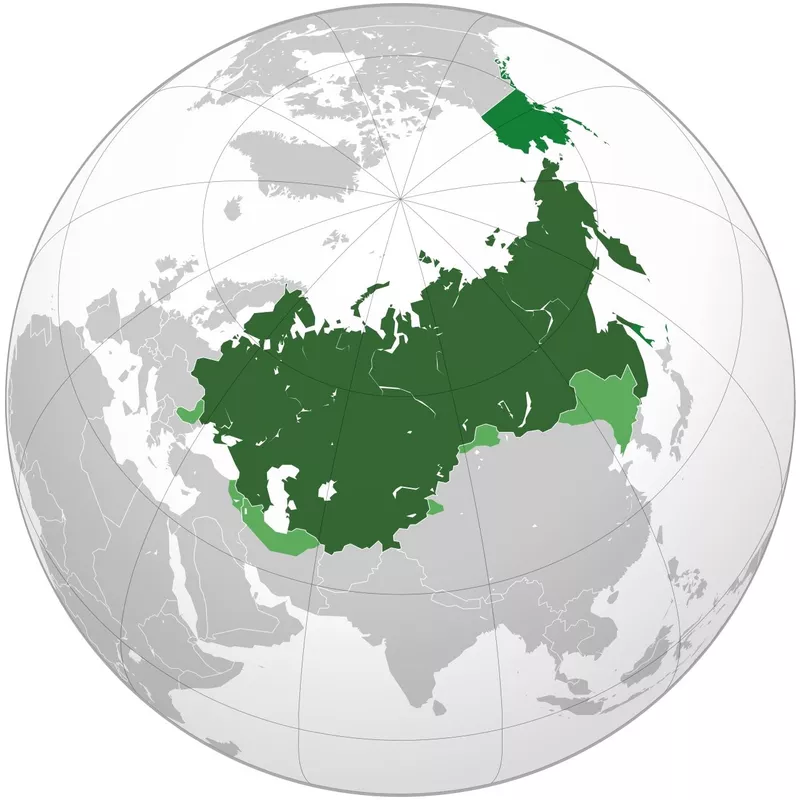
Map of the Russian Empire at its peak. Wikipedia
Years: 1721-1917
Maximum land area year: 1895
Millions of square miles occupied: 8.8
Percentage of the world: 16.92 percent
The Russian Empire Ended With a Revolution
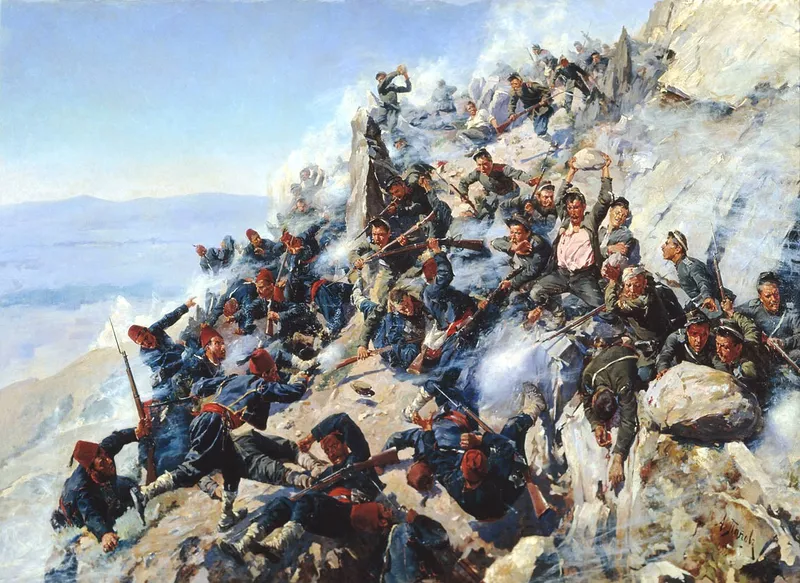
"The Defense of the Eagle's Nest," Alexey Popov, 1893.
The Russian Empire had some incredible rulers, like Ivan the Great, Peter the Great, Elizabeth of Russia, Catherine the Great and Alexander I. At its height, during the end of the 19th century, Russia controlled about one-sixth of the world's landmass.
The Russian Empire ended with Nicholas II, who was overthrown in 1917 by a group of Communists led by Vladimir Lenin and Leon Trotsky.
In 1918, the remaining members of the Romanov family, which had ruled Russia for 300 years, were executed.
2. Mongol Empire
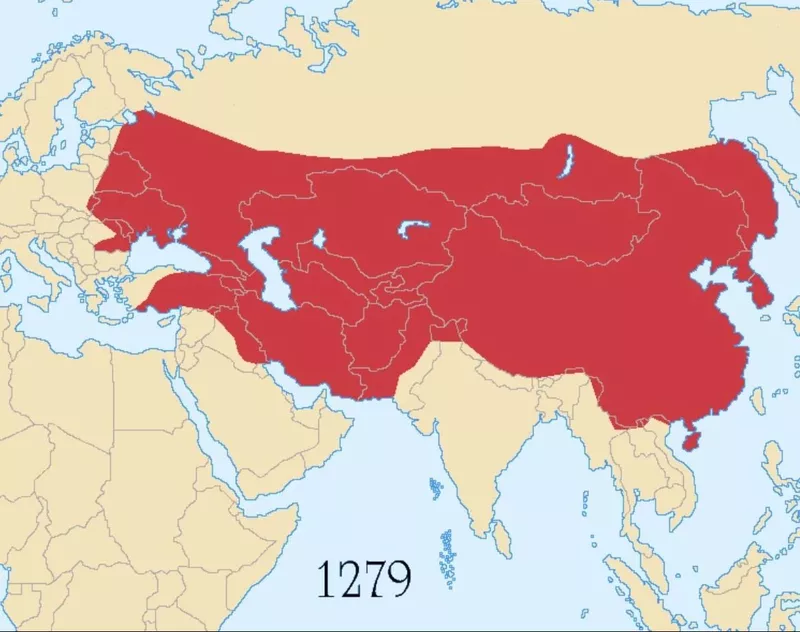
Map of the Mongol Empire at its height. Astrokey44/Sting / Wikiepdia
Years: 1206-1368
Maximum land area year: 1279
Millions of square miles occupied: 24
Percentage of the world: 17.81 percent
The Mongols Were Fearsome
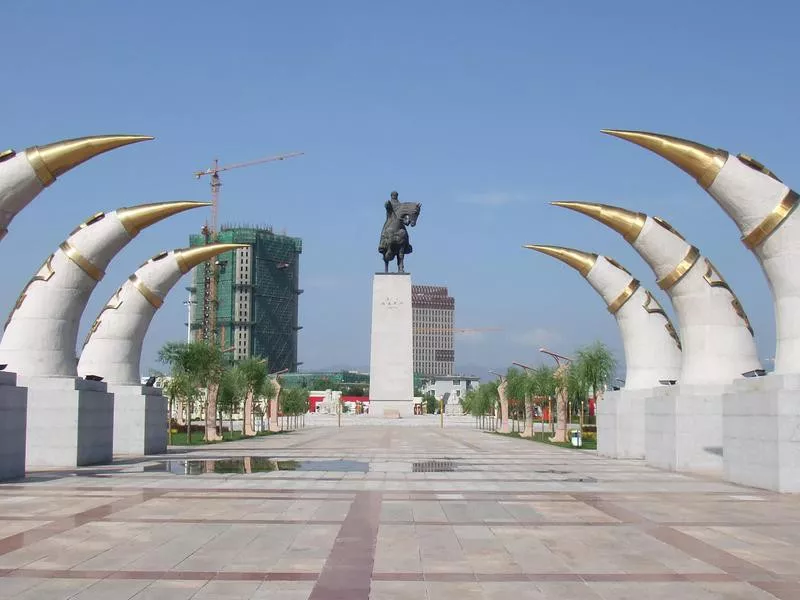
Monument of Genghis Khan in Hohhot, Inner Mongolia, China. Fanghong / Wikipedia
The Mongol Empire is one of the most famous empires in history.
Genghis Khan united several nomadic tribes, creating the most feared invaders of the 13th century. During Khan's reign, they seemed to have an endless supply of men, who, if an army were defeated, would come back with an even larger force to crush their neighbors.
The Mongol Empire began to fall apart in 1259, after the death of Mongke Khan. His lack of an heir apparent ignited a civil war and led to the fracturing of the Mongol Empire into four different powers, including the Yuan dynasty, which ruled over present-day China.
1. British Empire
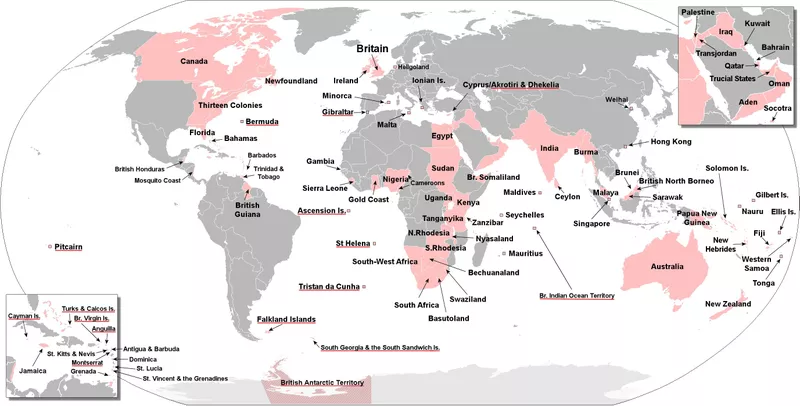
Areas that at one time or another were part of the British Empire.
Years: 1707-1997
Maximum land area year: 1920
Millions of square miles occupied: 13.71
Percentage of the world: 26.35 percent
The British Empire Didn't Totally End Until 1997
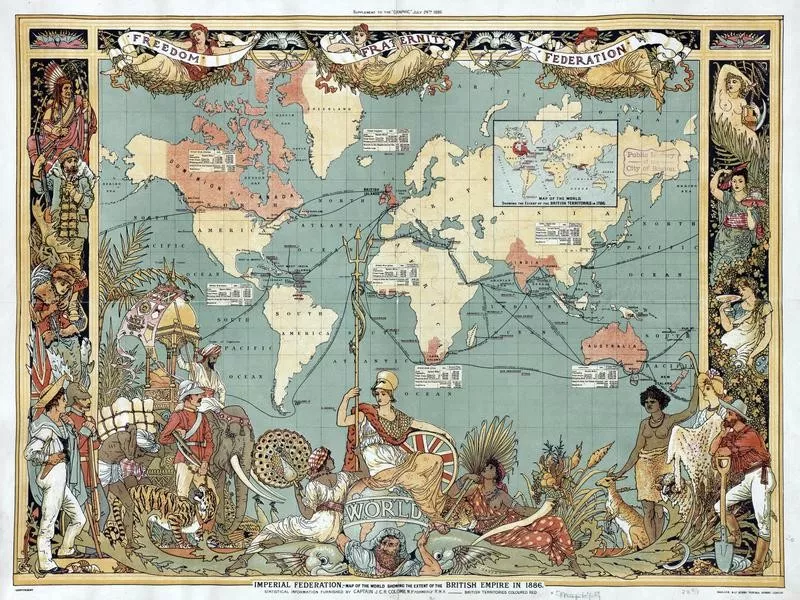
Map of the world showing the extent of the British Empire in 1886. John Charles Ready / Norman B. Leventhal Map & Education Center
The reach of the British Empire during its extent was remarkable. By the early 1900s, the country had an imperial population of some 412 million people, nearly a quarter of the world's population.
Britain has a long and bloody history of rule and subjugation throughout the world, as would be expected from any empire even a tenth of its size. It lost its grip on many nations after enduring World War II, which left Britain bankrupt and unable to keep control over places like Malay, Palestine and Ghana.
Eddie Izzard has a bit from "Dress to Kill" that sums it up:
"So after the second world war, the whole world was going, 'Come on, Europe, give these countries back. Come on, we had a bloody war, let's give 'em back. Britain?'
'What?'
'What's that behind your back?'
'Oh, it's India and a number of other countries.'
'Give them back.'
'Oh alright...'"
In 1997, Hong Kong was returned to China, completely ending what was left of the British Empire.
